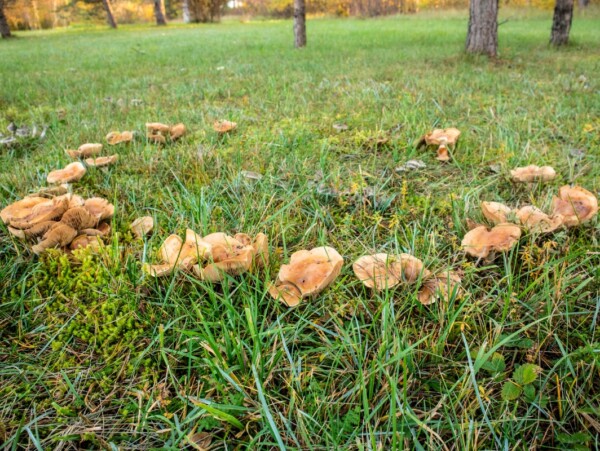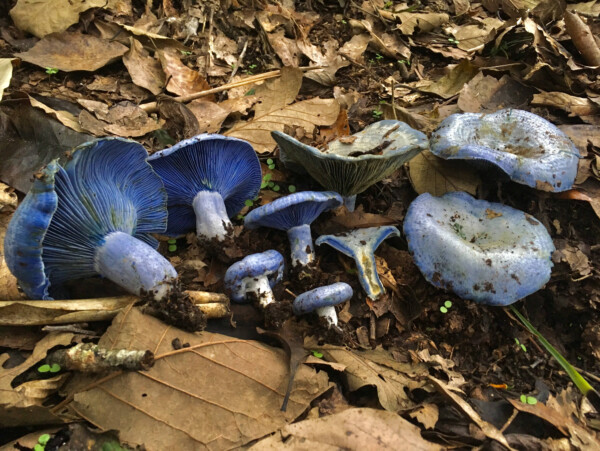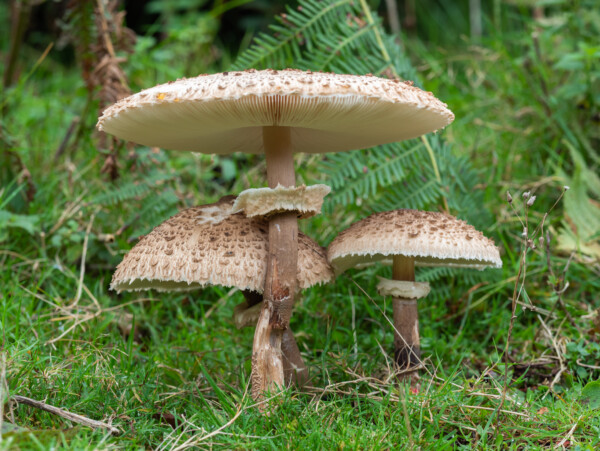Affiliate disclosure: This post may contain affiliate links. Please see our Privacy Policy.
Summer mushroom foraging is often means big baskets and bountiful harvests, as there are plenty of edible wild mushrooms in the woods this time of year. It’s a great excuse to beat the heat with a stroll through a cool shady spot in the woods, where most mushrooms thrive.

Summer weather generally means we spend more time outdoors. Whether you’re hiking, biking, visiting swimming holes, or just playing in a local park, summer is a great time to look for mushrooms!
Many prized culinary and medicinal mushrooms fruit during the long, hot days of summer. Some species can tolerate dry conditions, but others will generally appear after you get a good summer rain.
If you’re already spending time outside, it’s a good idea to bring a mesh bag or basket with you. Summertime is an abundant time for wild edibles, and learning to identify them can help ensure you don’t miss out on the bounty!
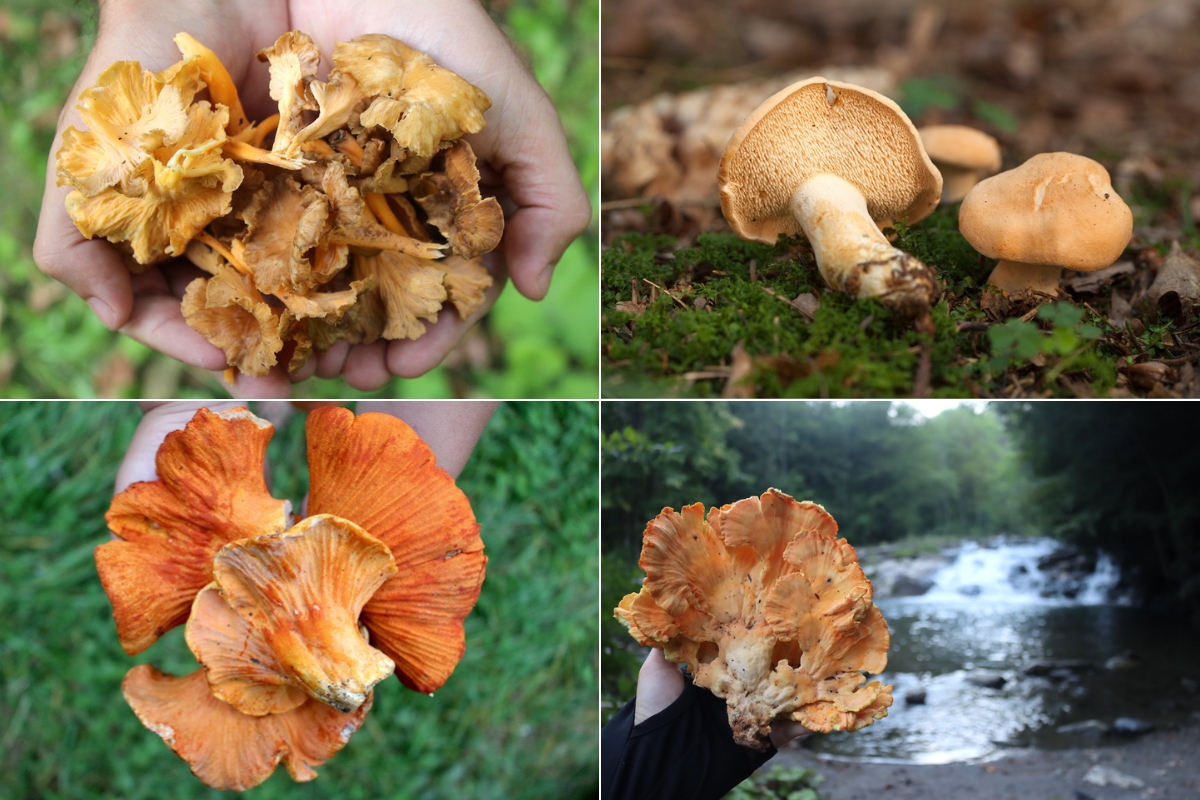
Summer Mushrooms
Each of these mushroom species is available during the summer months. The exact time may vary widely depending on the weather and your location. Some of these species are tasty edible mushrooms, while others are better suited to herbal preparations like teas and tinctures.
I’ve listed these mushrooms in order from those that are easy to identify and suitable for beginners to those that are more challenging and suitable only for expert foragers. Of course, other foragers may have different opinions on exactly how to rank these mushrooms; this is just my experience.
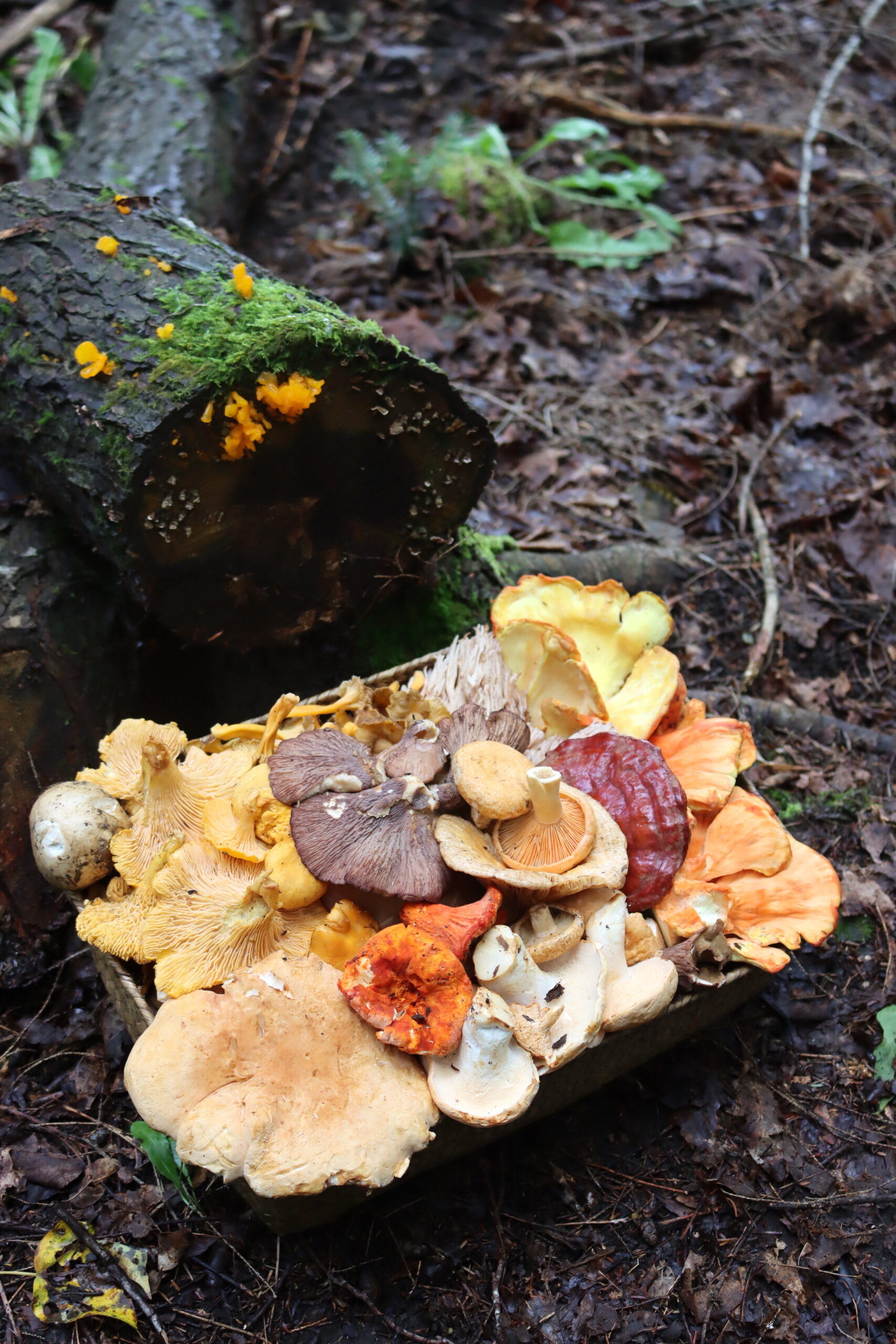
Beginner Foragers
- Black Trumpet Mushrooms (Craterellus cornucopioides)
- Chicken of the Woods (Laetiporus sulphureus)
- Shaggy Mane Mushrooms (Coprinus comatus)
- Reishi Mushrooms (Ganoderma spp.)
- Lion’s Mane Mushrooms (Hericium erinaceus)
- Maitake Mushrooms (Grifola frondosa)
- Black Staining Polypore (Meripilus sumstinei)
- Hedgehog Mushrooms (Hydnum repandum)
- Hawks Wing Mushroom (Sarcodon imbricatus)
- Witches Butter (Tremella mesenterica)
Intermediate Foragers
- Chanterelles (Cantharellus spp.)
- Puffball Mushrooms (Calvatia spp., Calbovista spp., Lycoperdon spp., etc.)
- Dryad’s Saddle (Cerioporus squamosus, formerly Polyporus squamosus)
- Old Man of the Woods (Strobilomyces strobilaceus)
- Turkey Tail Mushrooms (Trametes versicolor)
- Summer Oyster Mushrooms (Pleurotus pulmonarius)
- Saffron Milk Caps (Lactarius deliciosus)
- Pigs Ear Mushrooms (Gomphus clavatus)
- Boletes (Boletus spp.)
- Lobster Mushrooms (Hypomyces lactifluorum)
- Beefsteak Mushrooms (Fistulina hepatica)
- Wood Ear Mushrooms (Auricularia spp.)
- Weeping Milk Cap (Lactifluus volemus)
Expert Foragers
- Honey Mushrooms (Armillaria mellea)
- Agaricus Mushrooms (Agaricus spp.)
- Caesar’s Mushrooms (Amanita caesarea)
- Coral Mushrooms (Clavariaceae spp.)
- Matsutake (Tricholoma matsutake)
- Deer Mushrooms (Pluteus pestatus and Pluteus cervinus)
- Parasol Mushrooms (Macrolepiota procera)
- Russula Mushrooms (Russula sp.)
- Amethyst Deceiver Mushrooms (Laccaria amethystina)
- False Morels (Gyromitra spp.)
Summer Mushrooms for Beginner Foragers
These summer mushrooms are some of my favorites for novice foragers to find. They are all relatively common and easy to identify with some basic information.
Black Trumpet Mushrooms (Craterellus cornucopioides)
These dark-colored mushrooms can be difficult to spot on the forest floor, but they’re a prize you don’t want to miss. Black trumpets have a rich, nutty, almost smoky flavor that’s even more concentrated if you dry them.
Black trumpets have no close lookalikes, making them easy for beginner foragers to identify. We have enjoyed them with many dishes, but they’re excellent alongside a steak or in cream sauce.
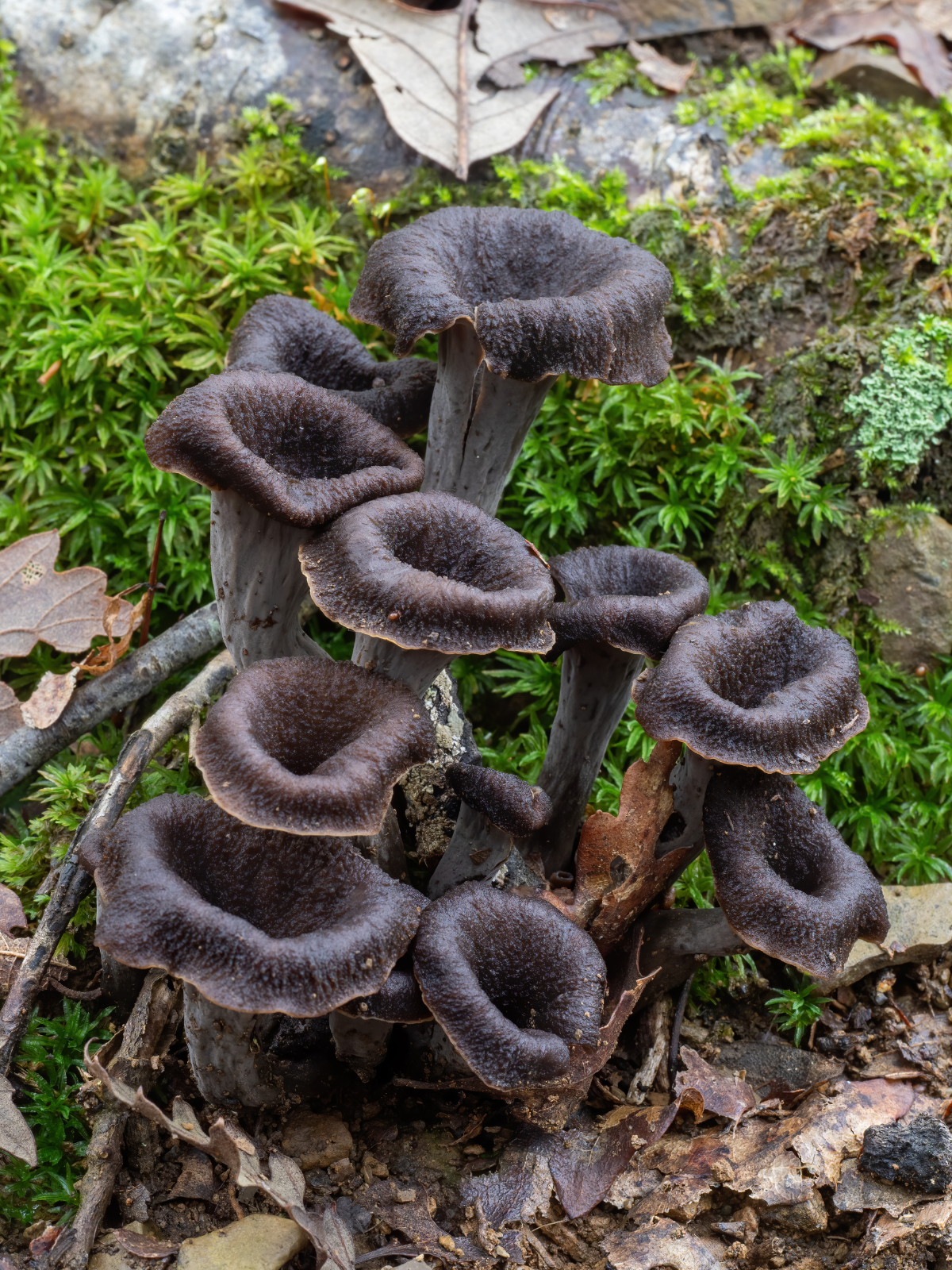
Chicken of the Woods (Laetiporus sulphureus)
Chicken of the Woods is one of the “foolproof four” mushrooms suggested for beginner foragers. It grows in overlapping clusters on dead wood and is brilliantly colored in shades of orange and yellow. There are no close lookalikes!
This mushroom isn’t just for novices, though. Its wonderful flavor and texture keep foragers coming back. As its name suggests, if you dredge this mushroom in a bit of flour and fry it, the taste and texture will be very similar to that of fried chicken breast.
It’s a great snack or the perfect vegan meat substitute.
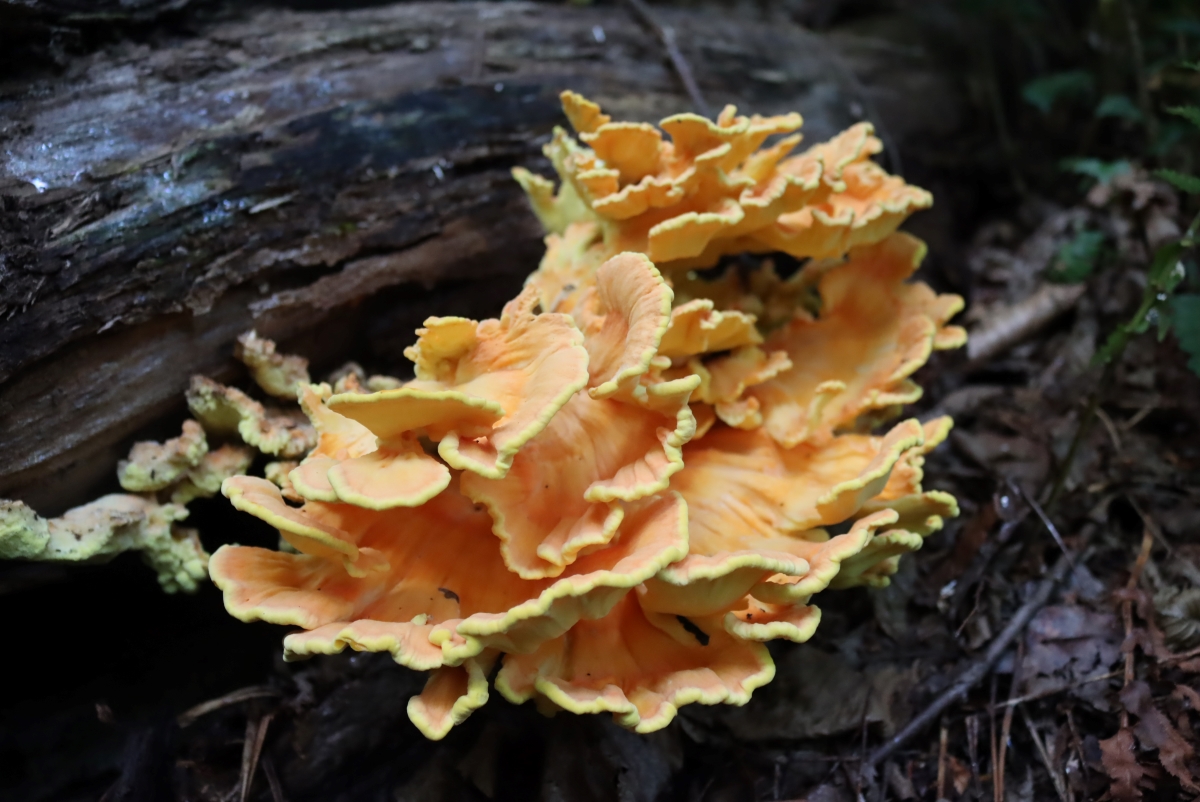
Shaggy Mane Mushrooms (Coprinus comatus)
Shaggy manes get their name from their odd, shaggy appearance caused by the dark, thin scales on their caps. This unusual style makes them easy to pick out for beginners; they’re part of the “foolproof four” mushrooms recommended to new foragers.
Unusual appearance aside, they’re a fun culinary mushroom. They usually dissolve in cooking, adding a striking black color and delicious flavor to creamy dishes like risotto.
Another great thing about these mushrooms is that they’re easy to find. Shaggy manes often grow in lawns, parks, and on roadsides, making them an excellent choice for urban foragers.
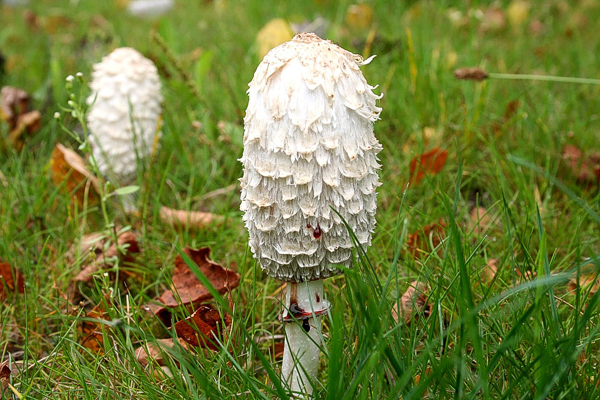
Reishi Mushrooms (Ganoderma spp.)
Reishi mushrooms are strikingly beautiful and easy to identify. They grow on dead and dying trees and when young, their caps are shiny with bands of red, orange, yellow, and white.
These colorful mushrooms are too tough to be edible, but don’t let that turn you off. Reishi mushrooms are among the most potent medicinal mushrooms and have been used by herbalists for generations.
They have analgesic, anti-inflammatory, antibacterial, antiviral, antioxidant, anti-allergic, and anti-tumor properties and are an excellent choice for making tinctures.
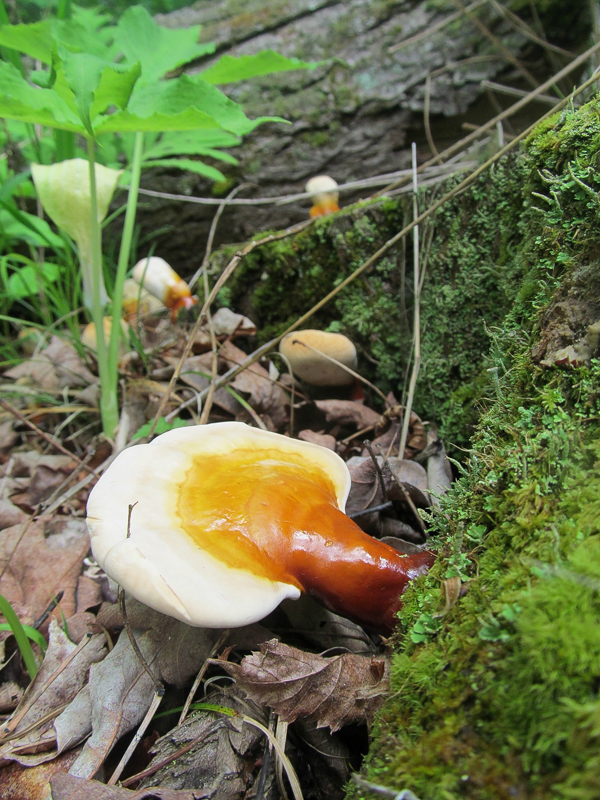
Lion’s Mane Mushrooms (Hericium erinaceus)
Lion’s mane mushrooms are another foolproof mushroom for beginners with no lookalikes. They’re delicious with a mild, seafood-like flavor and potent medicinal benefits.
These white, unusual-looking mushrooms grow from dead or dying hardwood, often up high. While Lion’s Manes are frequently listed as fall mushrooms, you can often find them in late summer, too.
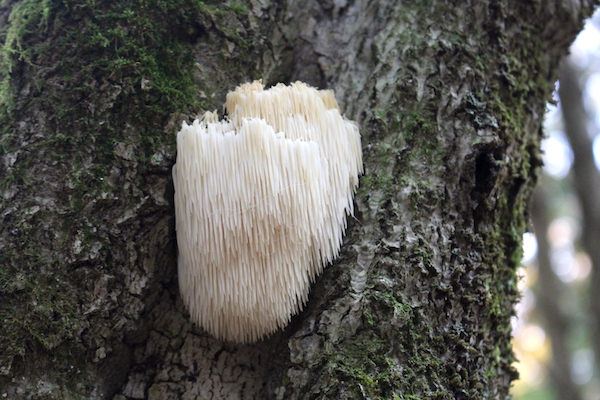
Maitake Mushrooms (Grifola frondosa)
Maitake is one of my favorite beginner mushrooms! Also known as Hen-of-the-Woods, maitake has incredible flavor and a few medicinal benefits.
Typically, foragers consider maitake a fall mushroom that may fruit as late as November. However, maitake may make an appearance in late summer, particularly in warmer climates like the southeastern United States, so it’s good to start watching for it in August.
Look for it growing on the base of old hardwood trees, like oaks that are over 100 years old.

Black Staining Polypore (Meripilus sumstinei)
Sometimes known as “rooster-of-the-woods,” this polypore is the lesser-known cousin of maitake and chicken-of-the-woods. Like its cousins, it grows in overlapping clusters on dead and dying hardwood, often near the base.
In many ways, it resembles maitake, though its caps tend to be much thinner and leathery. As the name suggests, the black-staining polypore also has the distinctive feature of bruising black.
For fresh eating, you want to cook the tender outer 1 inch of the mushroom. While the rest of the mushroom is too leathery to be eaten like chicken-of-the-woods, the black-staining polypore’s incredible umami flavor makes it an excellent choice for stocks and powders.
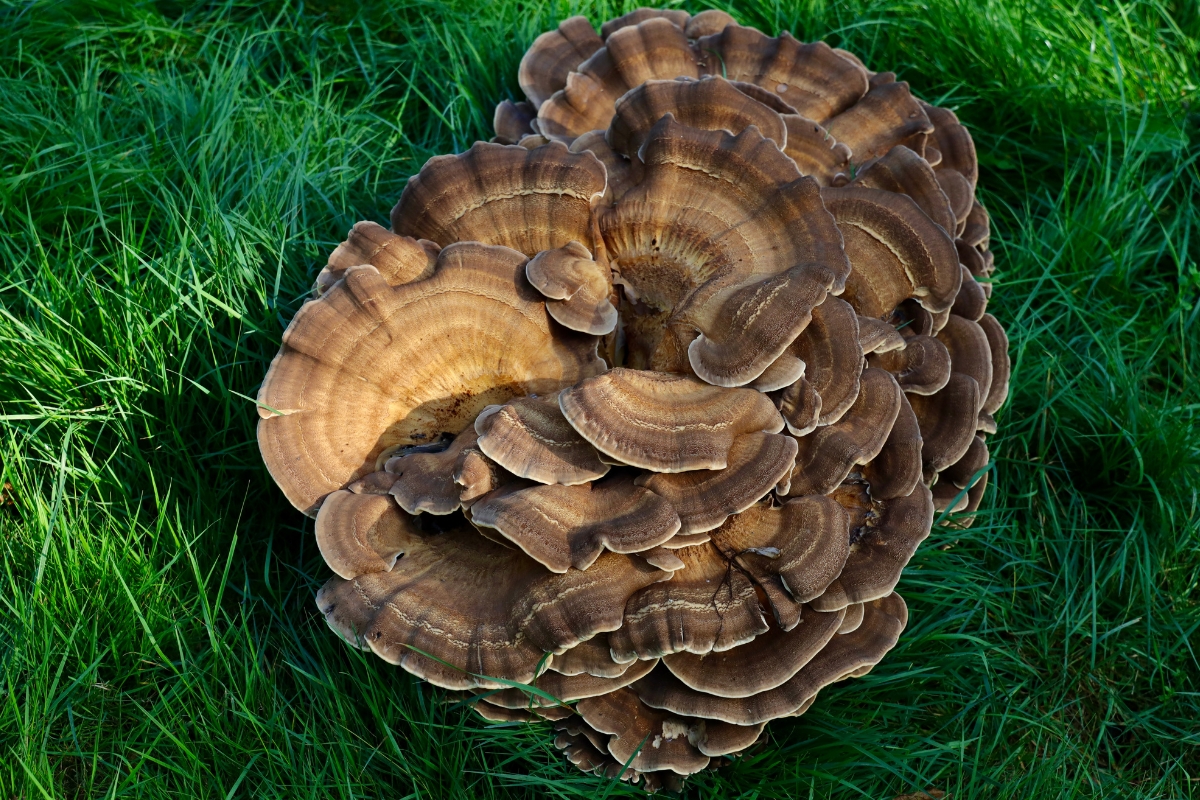
Hedgehog Mushrooms (Hydnum repandum)
Hedgehog mushrooms are a must-have for your summer foraging list. These gourmet mushrooms have a unique, spiked pore surface that resembles a hedgehog. This odd feature makes them easy to identify for new foragers.
Hedgehog mushrooms have a subtle flavor, making them versatile in the kitchen. You can add them to many dishes, such as stew, omelets, pasta, or grilled cheese, or serve them as a side with meat.
Look for hedgehog mushrooms growing on the forest floor of mixed woodlands.
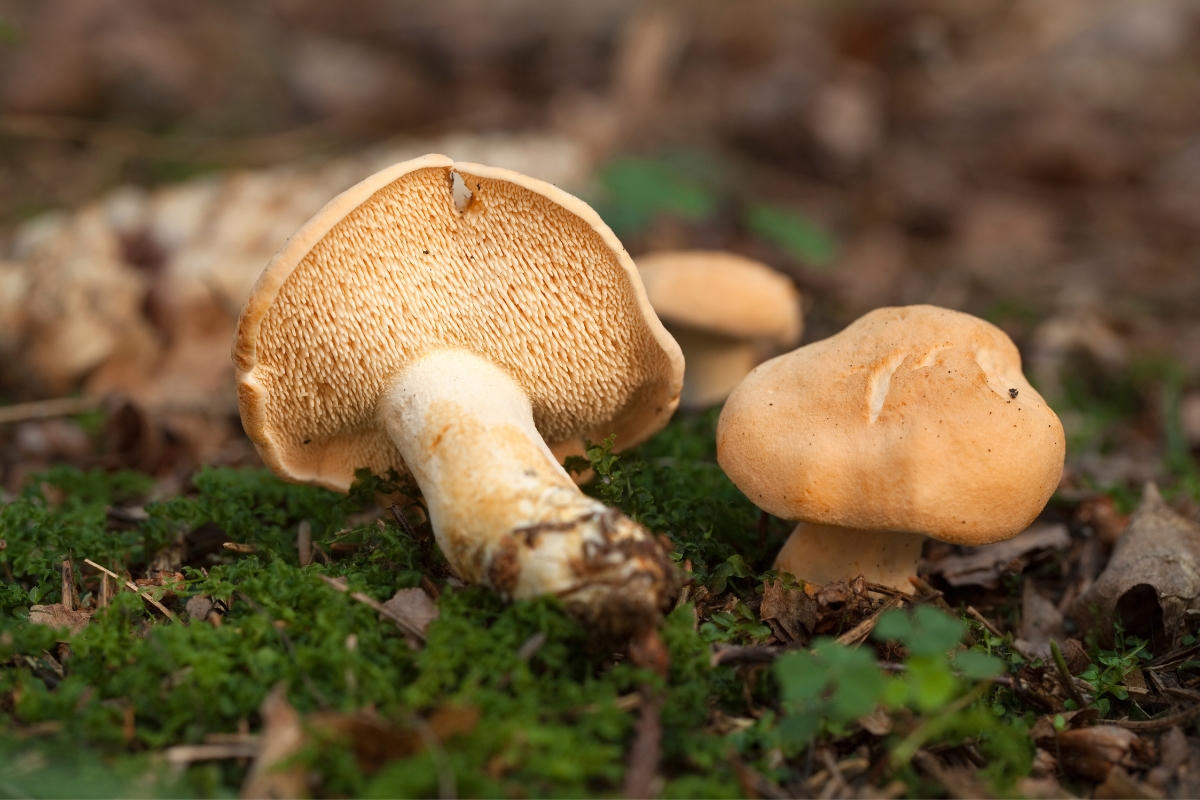
Hawks Wing Mushroom or Scaly Hedgehog (Sarcodon imbricatus)
Scaly hedgehogs are impressive-looking mushrooms with brown, scaly caps reaching up to 12 inches (30 cm) in diameter. In place of gills or pores, they have tooth-like structures. You can find scaly hedgehog mushrooms growing beneath spruce, pine, or occasionally hardwood forests.
Some sources report that scaly hedgehogs have a bitter flavor, while others find them highly enjoyable. Scaly hedgehog mushrooms are usually fried, and some Swedish recipes recommend using them with pasta.
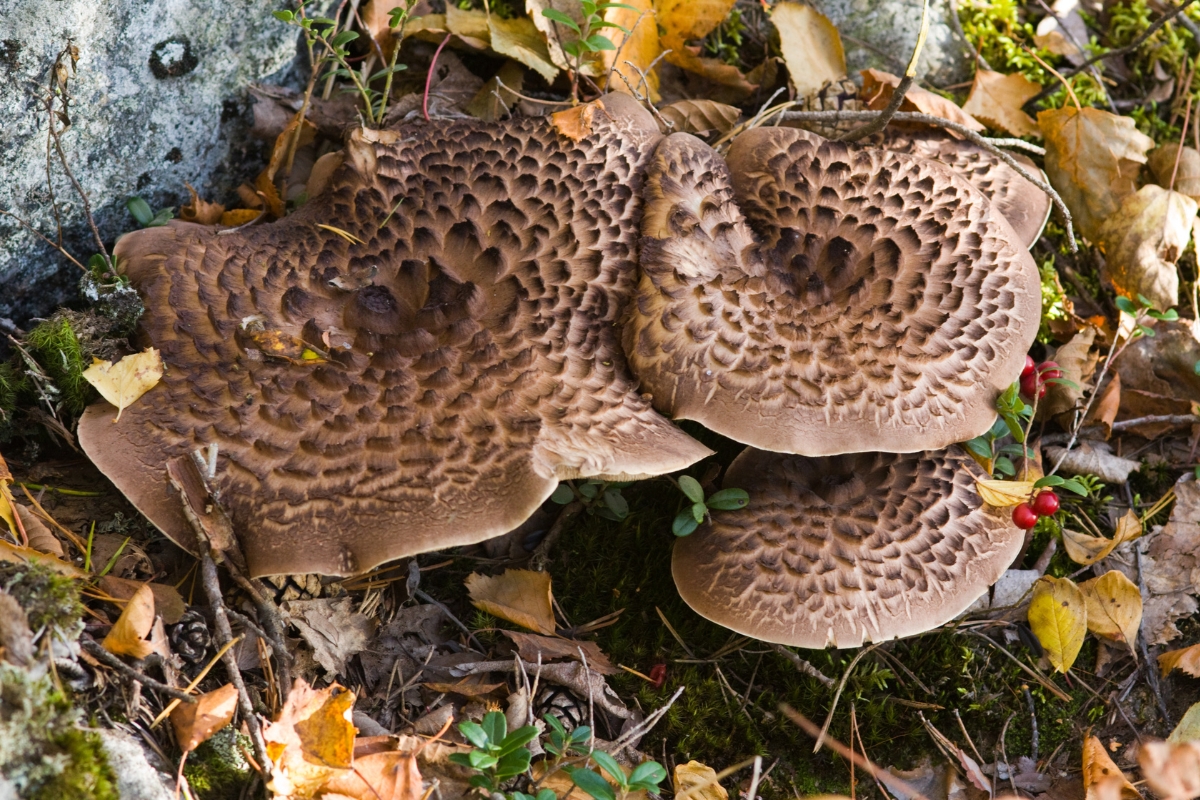
Witches Butter (Tremella mesenterica)
Available year round, witches butter will sprout from dead logs no matter the season. All it really requires is adequate moisture.
You’ll usually find witches butter after heavy rains, especially on decomposing logs with ground contact, since they tend to retain moisture.
It’s both edible and medicinal, though not generally considered super flavorful. It’s most commonly used medicinally for respiratory complaints.
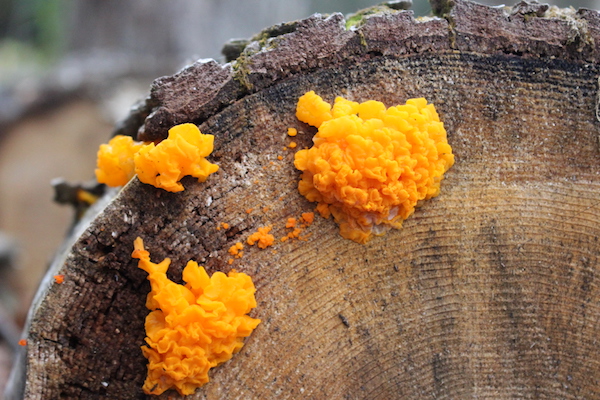
Summer Mushrooms for Intermediate Foragers
The mushrooms in this section are a bit trickier to identify than those in the beginner section but can be quickly recognized with some practice.
A few of them have toxic lookalikes, such as the edible chanterelle and the toxic jack-o’lantern mushroom. However, in these cases, the differences between them are easily spotted by a fairly experienced forager.
Chanterelles (Cantharellus spp.)
Chanterelles are among foragers’ most coveted mushrooms. They have a unique blend of nutty, fruity, and peppery flavors and are incredibly versatile. We’ve used them to make soup, pasta, omelets, cheesecake, and even ice cream!
Most are wonderfully aromatic, and smell like fresh apricots.
There are many species of chanterelle, all with similar identification characteristics. Fun ones to look for this summer include:
- Smooth chanterelle (Cantharellus lateritius)
- Cinnabar chanterelle (Cantharellus cinnabarinus)
- Teeny tiny chanterelle (Cantharellus minor)
Chanterelles mushrooms are also difficult to impossible to grow, so you won’t find them anywhere but the wild. They thrive only in well-established forests, so you’ll have to forage if you want to enjoy them. Just be aware that there are some toxic lookalikes, such as the jack-o-lantern mushroom.
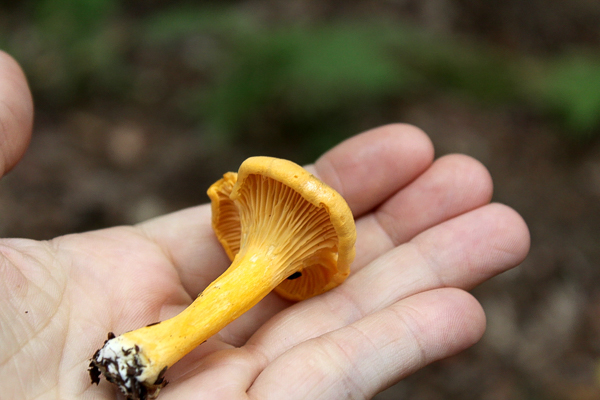
Puffball Mushrooms (Calvatia spp., Calbovista spp., Lycoperdon spp., etc.)
The giant puffball may be the most well-known but there are dozens of species of tasty puffball mushrooms! Unfortunately, there are also some toxic look-alikes, including the common earthball.
Once you learn to identify the correct ones, there are so many fun ways to use these versatile mushrooms. You can slice the giant ones and make them into the “crust” for puffball pizza, dry them for puffball powder, use them as a tofu substitute, or just brown them in a bit of butter or oil.
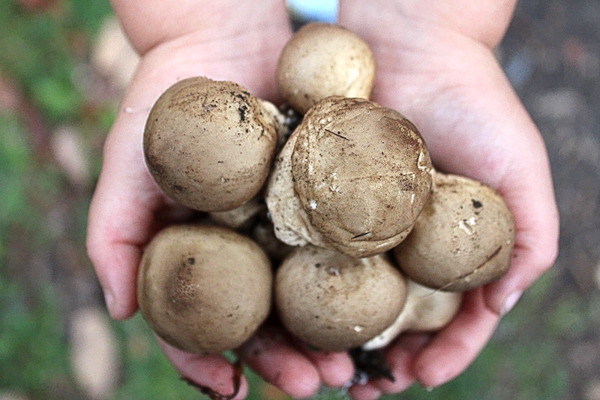
Dryad’s Saddle (Cerioporus squamosus, formerly Polyporus squamosus)
Dryad’s saddles are beautiful tan mushrooms speckled with darker brown scales that have earned them the nicknames pheasant’s backs and hawk’s wings. They grow on logs.
When you find small, young, tender mushrooms, they’re excellent sauteed. However, these mushrooms reach enormous sizes and get tougher as they grow. While large mushrooms aren’t as ideal, they still make a delicious mushroom broth.
In warm climates, these mushrooms may only fruit in the late winter, early spring, or fall when conditions are cool and moist. However, in northern climates like Vermont, they may fruit in late spring, early summer, or fall.
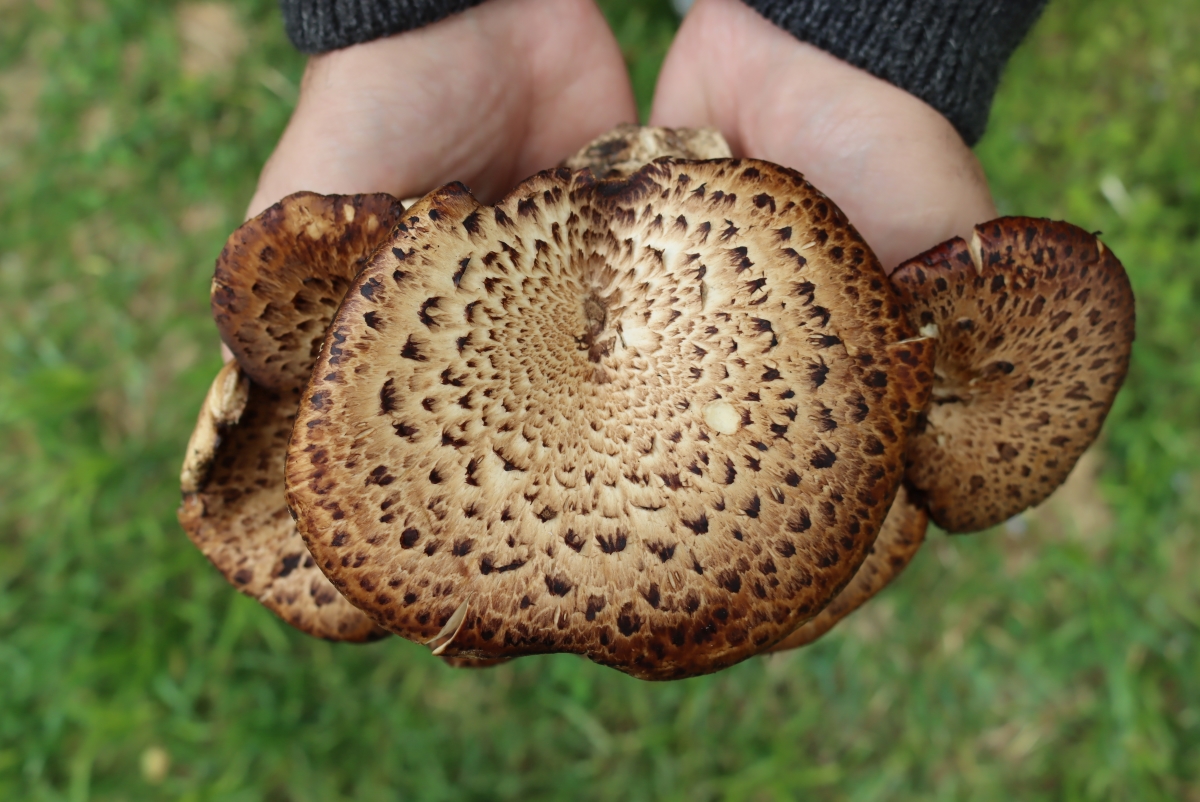
Old Man of the Woods (Strobilomyces strobilaceus)
Old man of the woods generally receives mixed reviews among foragers. Some find it bland and unexciting, while others proclaim their love for it. Either way, it’s edible, incredibly easy to identify, and widespread.
Old man of the woods often grows in groups in deciduous or coniferous forests. Its distinct caps have a dark, ragged appearance due to their covering of dark gray to black pyramidal scales. Once you’ve seen it, there are few mushrooms you could confuse with it.
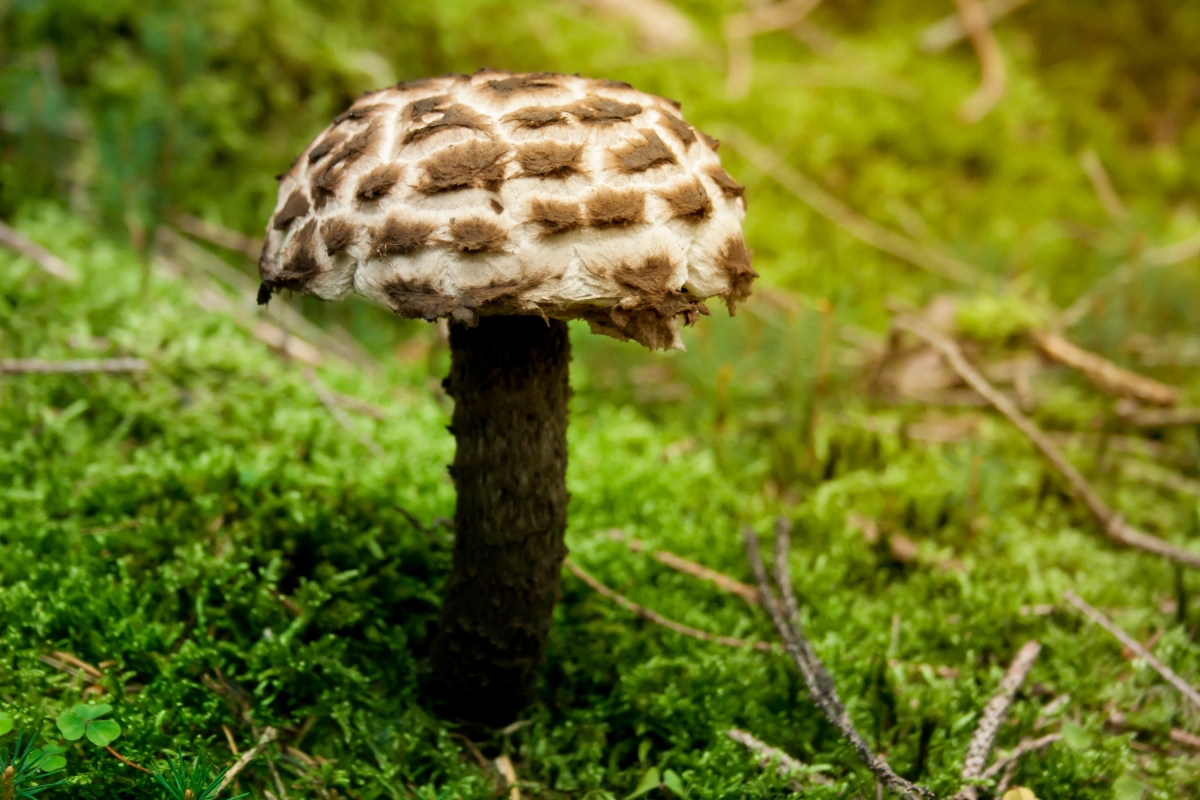
Turkey Tail Mushrooms (Trametes versicolor)
Turkey tail mushrooms are among the few mushrooms that you can find nearly any time of year. Their thin, banded caps grow in clusters on dead trees.
Though turkey tail mushrooms are much too leathery to use in the kitchen, they are great for tinctures. They may help support the immune system, fight cancer and infections, and improve digestive issues.
Turkey tail mushrooms do have a few lookalikes, so it’s important to follow a checklist like ours when foraging for them.
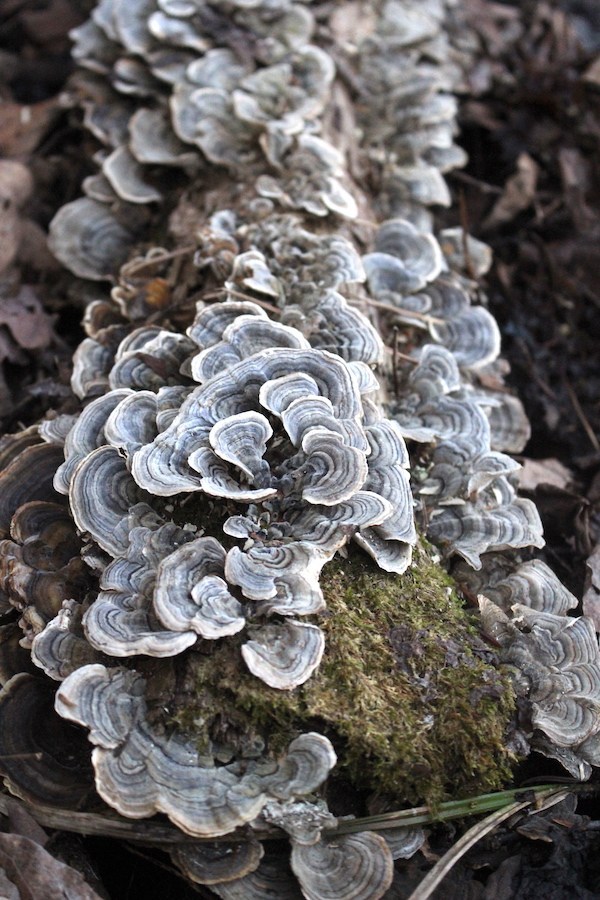
Summer Oyster Mushrooms (Pleurotus pulmonarius)
There are many species of oyster mushrooms, and all of them are edible and tasty. As its name suggests, the summer oyster is one of the most common species I find fruiting in summer. It has pearly white caps and grows in large overlapping clusters on dead and dying hardwood trees. Often, you can get a large harvest from a single tree.
Summer oyster mushrooms have more protein than most mushrooms, a pleasant texture, and a subtle flavor. They are excellent pan-fried and then tossed onto other dishes like pasta, pizza, and salad.
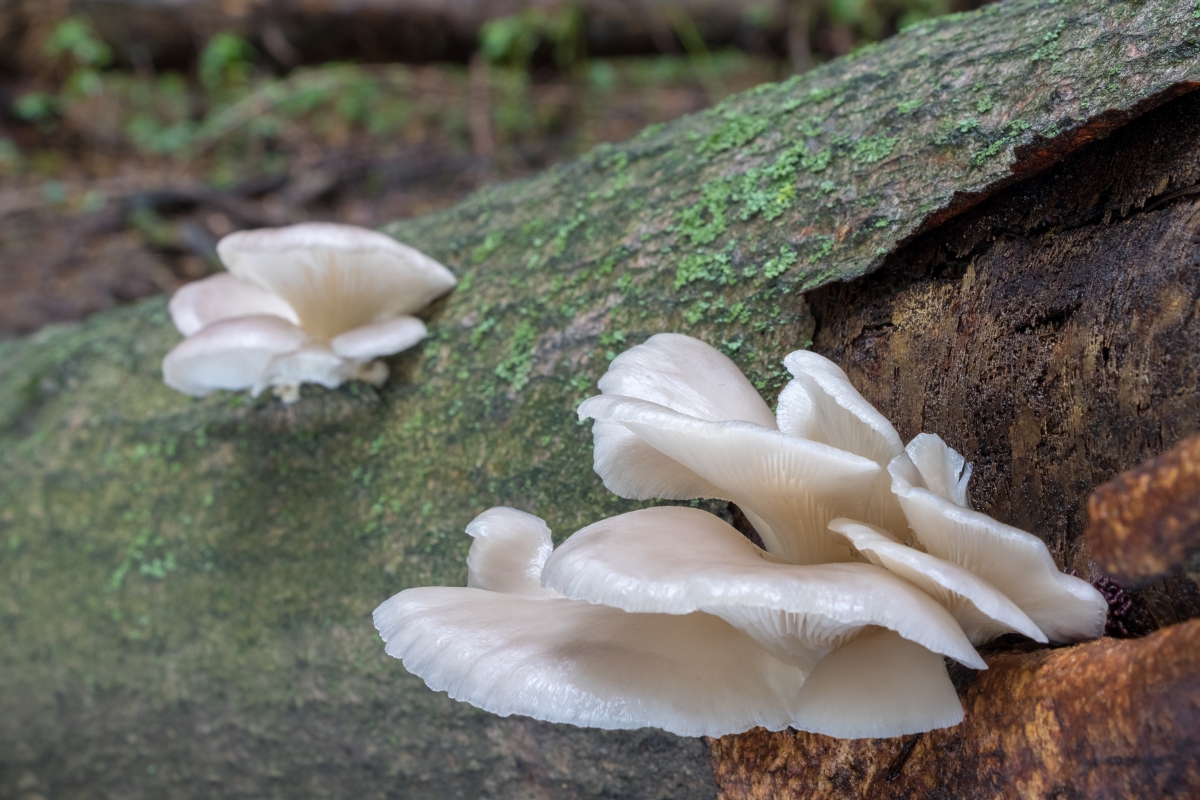
Saffron Milk Caps (Lactarius deliciosus)
Saffron Milk Caps are renowned worldwide for their excellent flavor. Strangely, they’re largely overlooked by U.S. foragers. This is incredibly disappointing, as their peppery flavor makes great soups, stuffed mushrooms, risotto, and other dishes.
To find saffron milk caps, you’ll need to hit the woods. These orange mushrooms grow in forests, especially pine forests. Many foragers report that they only fruit well after good rain, so be sure to check after storms.
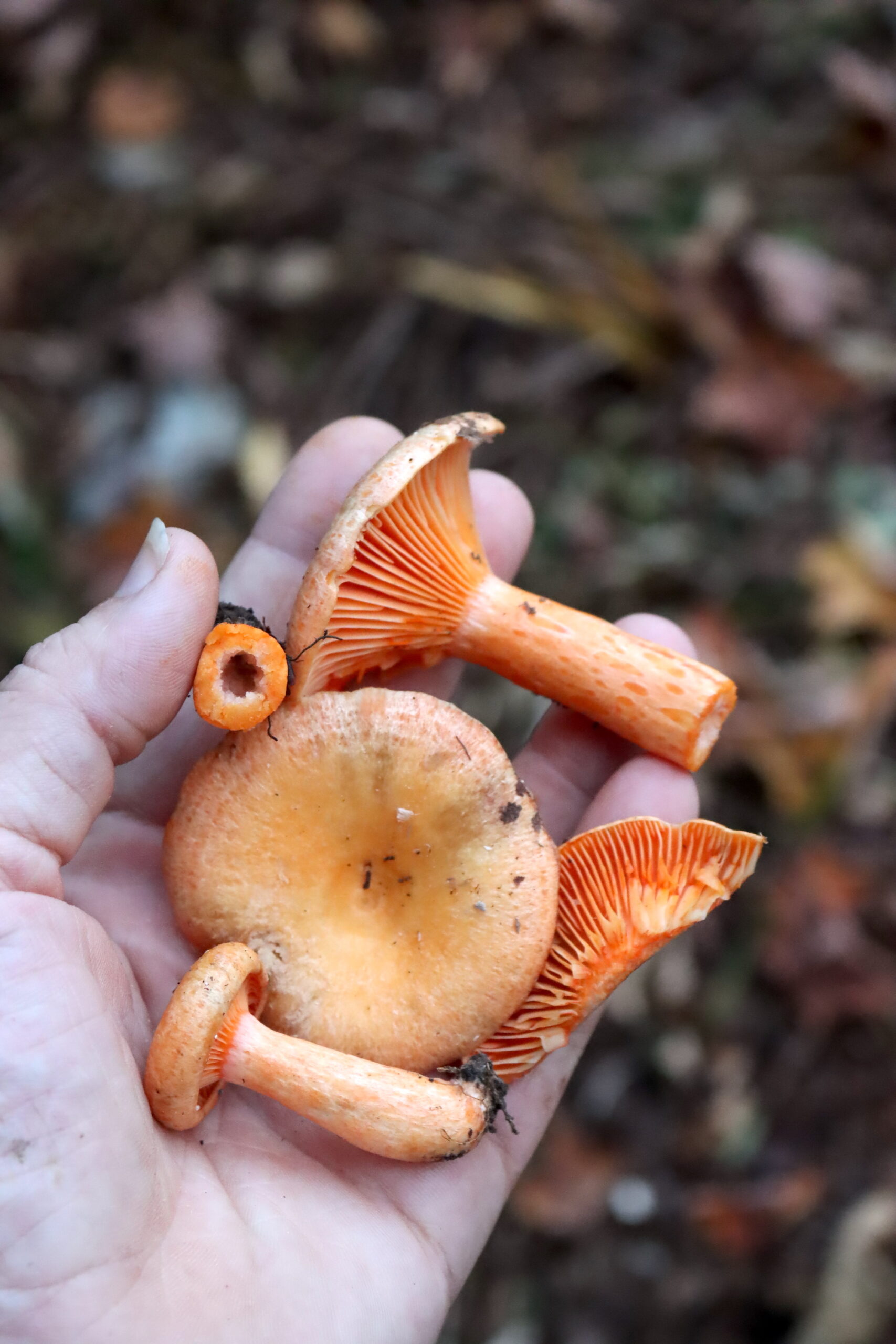
Pigs Ear Mushrooms (Gomphus clavatus)
If you find Pigs Ear Mushrooms, you know you’re in a special place. These tasty mushrooms are usually associated with old-growth forests. Your grandparents may remember them fondly but these days, they’re more difficult to find.
Pigs ear mushrooms are sometimes called violet chanterelles due to their chanterelle-like appearance and striking purple color. Their flavor is unique and strong, nothing like that of the chanterelle.
Harvest these mushrooms respectfully, as they appear to be declining in many areas.
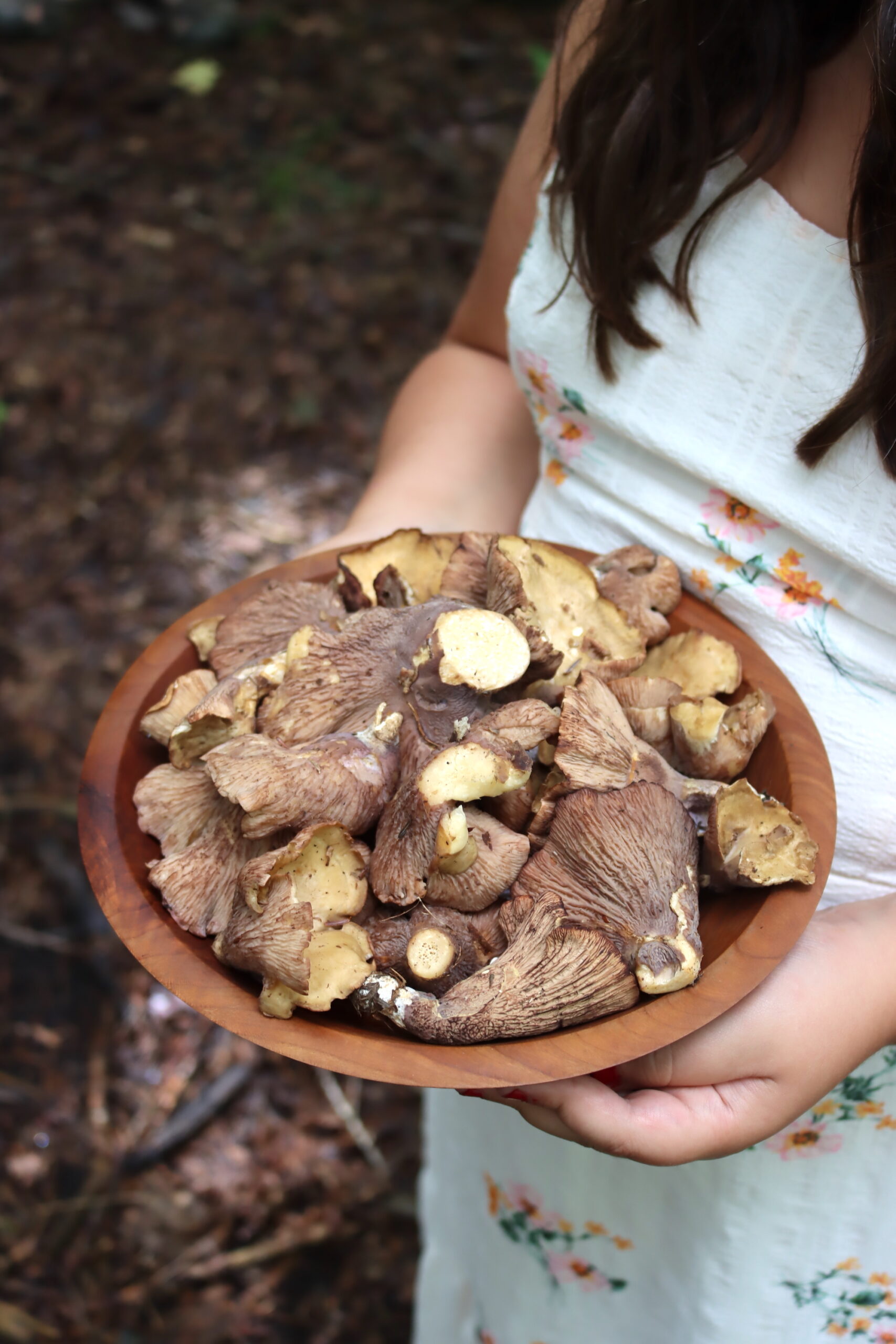
Boletes (Boletus spp.)
Boletes’ wide range and incredible flavor have made them stars in the fungi and foraging world. With their large bread-bun-like caps, the king boletes are particularly popular, but many other species are just as tasty.
Boletes are generally summer mushrooms that fruit on the floor of forests across the northern hemisphere. There are quite a few species, all with similar identification characteristics. Some fun summer bolete species include:
- Weeping Bolete (Suillus granulatus)
- Chicken fat bolete (Suillus americanus)
- Chestnut bolete (Gyroporus castaneus)
- Gilled bolete (Phylloporus rhodoxanthus)
- Apple bolete (Exsudoporus frostii)
And, many more.
They’re fairly easy to identify, but there are a few lookalikes and toxic species, so learning to discern them properly is essential.
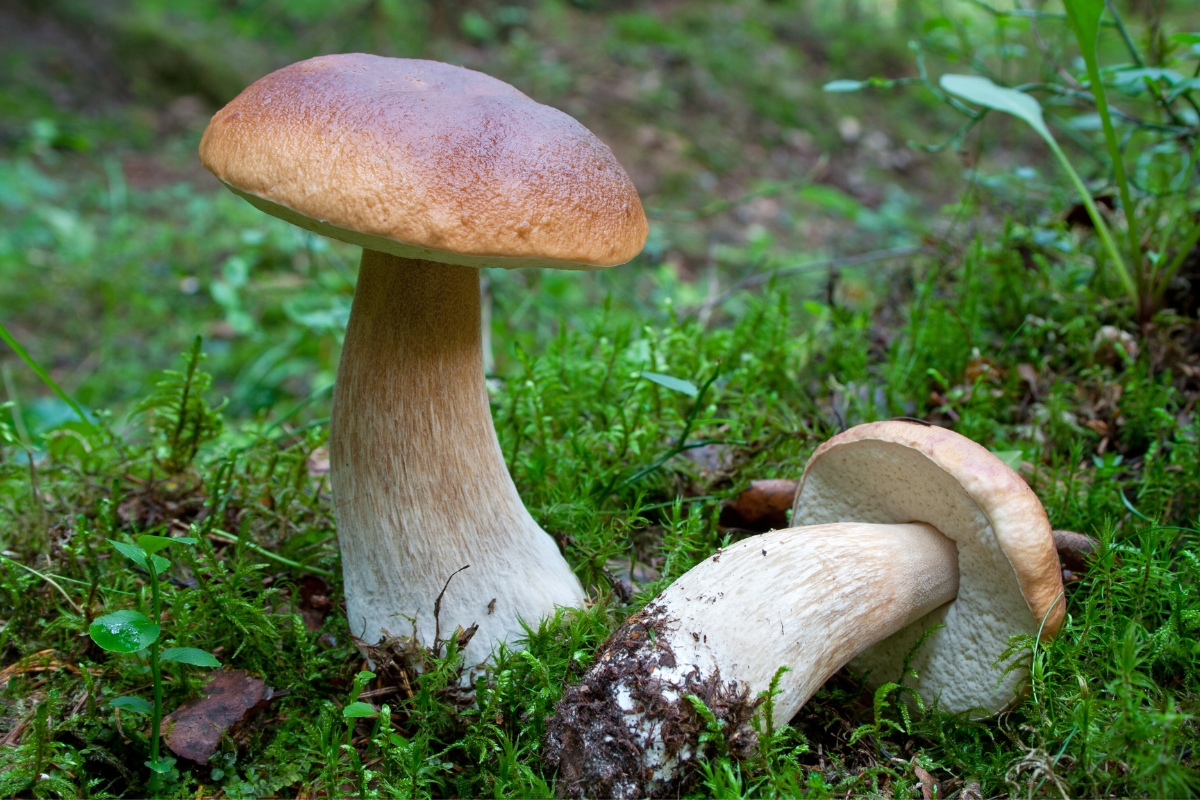
Lobster Mushrooms (Hypomyces lactifluorum)
Lobster mushrooms may be the weirdest mushrooms on this list! They aren’t technically mushrooms at all but parasitic ascomycete fungi that colonize other mushrooms, such as brittle gills (Lactarius spp.) and milk caps (Russula spp.).
When this fungus colonizes other mushrooms, it changes their appearance, flavor, and DNA! This process isn’t great for the mushrooms but is excellent for foragers.
Once the fungus has taken over, these mushrooms will have a firm texture, an orangeish-red color similar to that of a cooked lobster, and a delightful, mild seafood-like flavor.
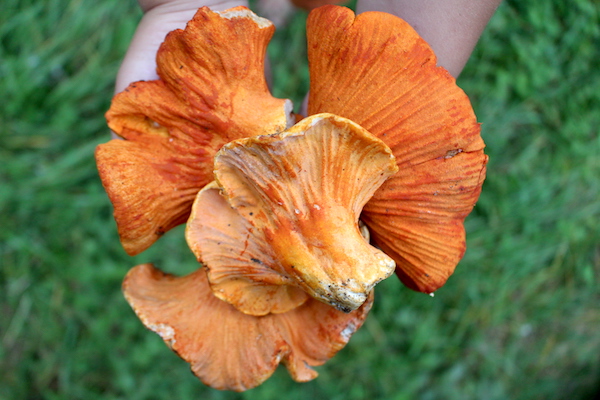
Beefsteak Mushrooms (Fistulina hepatica)
Beefsteak mushrooms are also known as steak of the woods and oxtongue for their red, meaty appearance. Don’t let their looks fool you. Unlike chicken of the woods, these mushrooms don’t taste like their namesake.
Beefsteak mushrooms have a very unique tart flavor and gelatinous texture. Unlike most wild mushrooms, which must be cooked, people worldwide often eat beefsteak mushrooms raw.
These mushrooms are probably unlike any you’ve tried, so it’s worth finding some. As you explore this summer, look for beefsteak mushrooms near the base of living or dead trees.
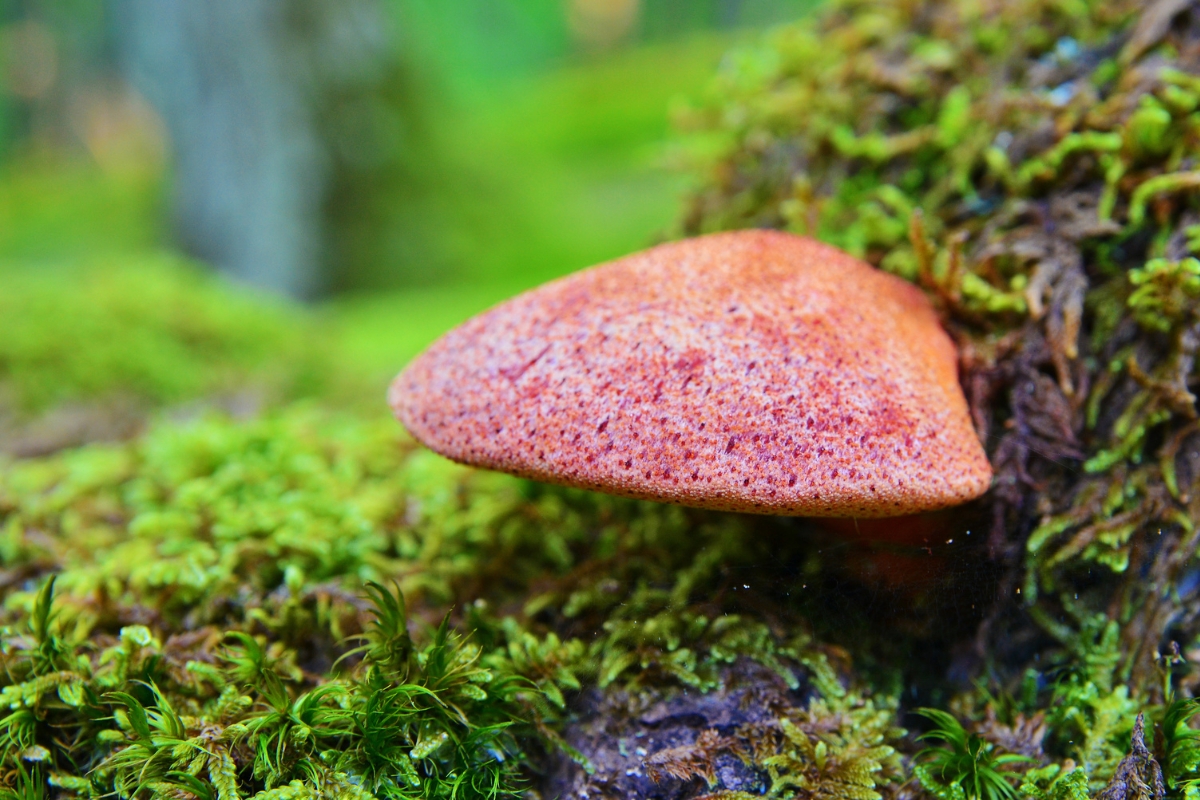
Wood Ear Mushrooms (Auricularia sp.)
If you come across a dead branch that looks like it has sprouted brownish, translucent human ears, you’ve probably found wood ear mushrooms! These odd-looking mushrooms are incredibly hardy and often fruit year-round, tolerating both hot and dry and cold and wet weather.
They’re also quite tasty and popular in Asian cuisines, such as Chinese wood ear salad. They have a mild, earthy flavor and are great at soaking in the flavor from soups and stews.
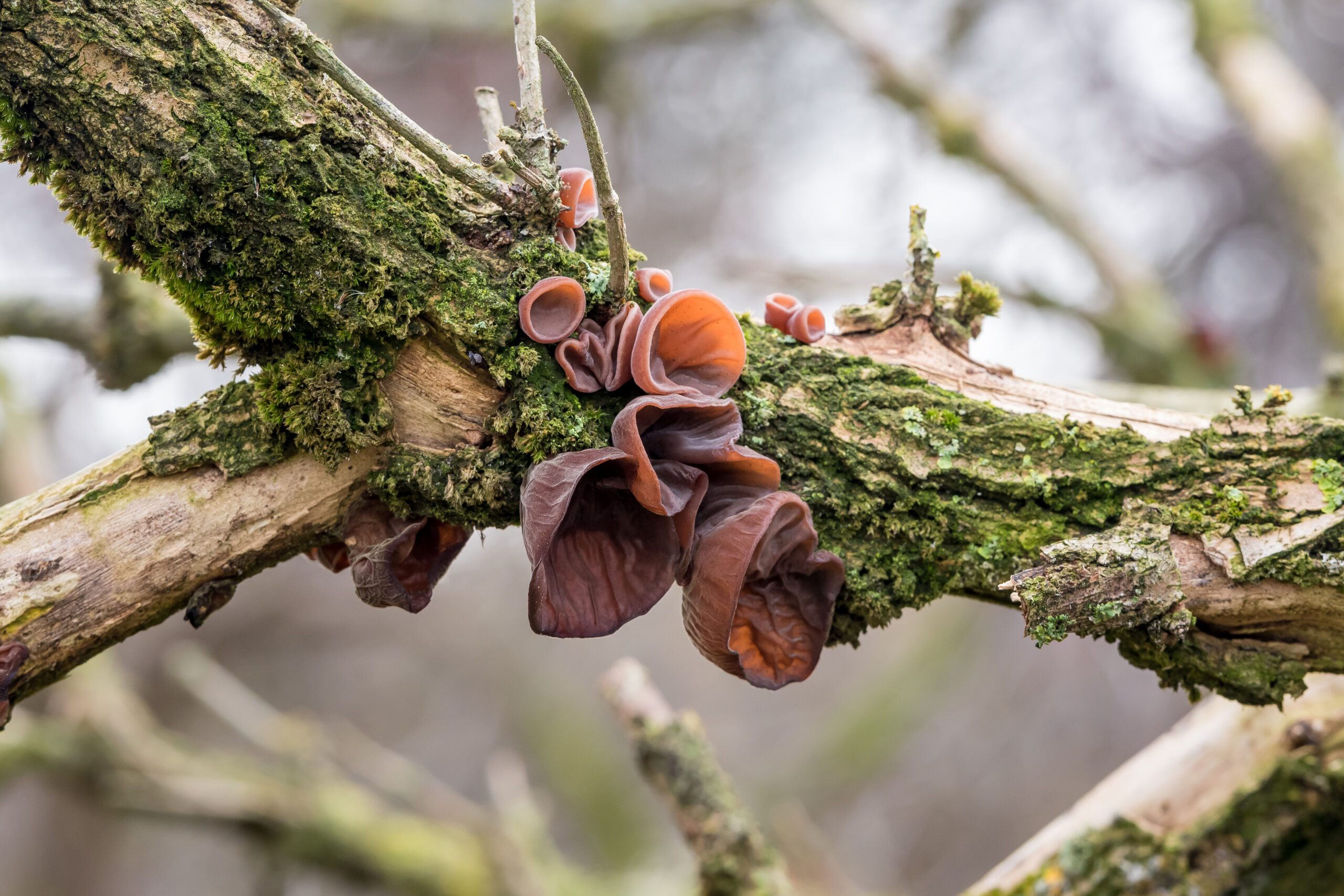
Weeping Milk Cap (Lactifluus volemus)
Weeping Milk Caps may not be an obvious choice for foragers. Their name refers to the large amount of white latex that exudes from damaged gills. It doesn’t look appealing, but don’t worry, it isn’t toxic!
They also have a distinct fishy, almost cheesy odor that you’ll notice immediately. Thankfully, neither of these features affects the weeping milk caps’ delicious meaty flavor and texture once they’re cooked.
The latex and odor also help make weeping milk caps relatively easy to identify. You can usually find them growing on the floor of mixed hardwood forests, but they’ll sometimes grow under conifers, too.
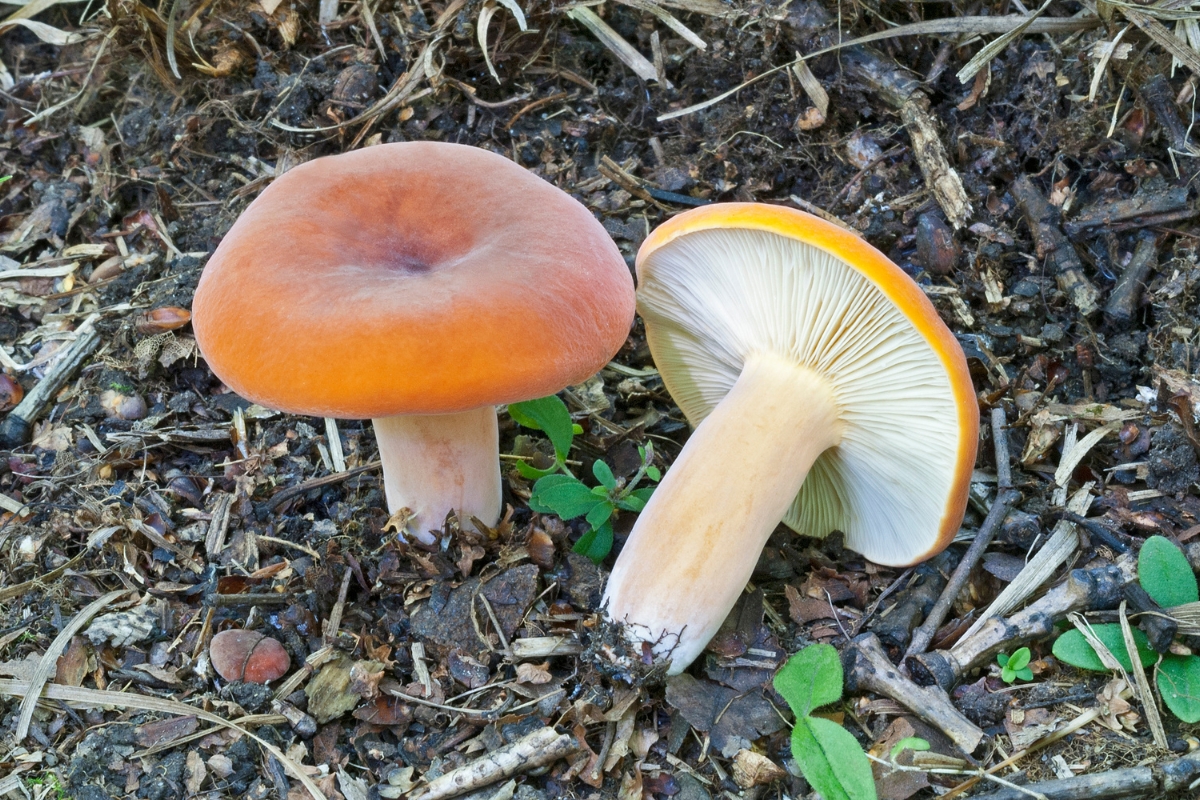
Mushrooms for Advanced Foragers (Not for Beginners!)
These mushrooms are only suitable for advanced foragers. Some are challenging to identify or have deadly toxic lookalikes. Others require careful preparation to be edible even after you have made a correct identification.
Finding these mushrooms is fun, but don’t try to use any of them unless you are 100% certain of your abilities and identification.
Honey Mushrooms (Armillaria mellea)
Honey mushrooms can be intimidating for new foragers because they’re a bit more challenging to identify and prepare than some other options. In my opinion, learning how to recognize and use honey mushrooms is worth it, as there’s a lot to love about this fungus.
Honey mushrooms are part of the largest organism on the planet! A network of this fungus covers about 2,384 acres in the Pacific Northwest.
Honey mushrooms have a moderately sweet flavor that’s nothing like store-bought button mushrooms. They may also be colonized by a fungus known as shrimp of the woods (Entoloma abortivum), which gives them a distinct appearance and seafood-like flavor.
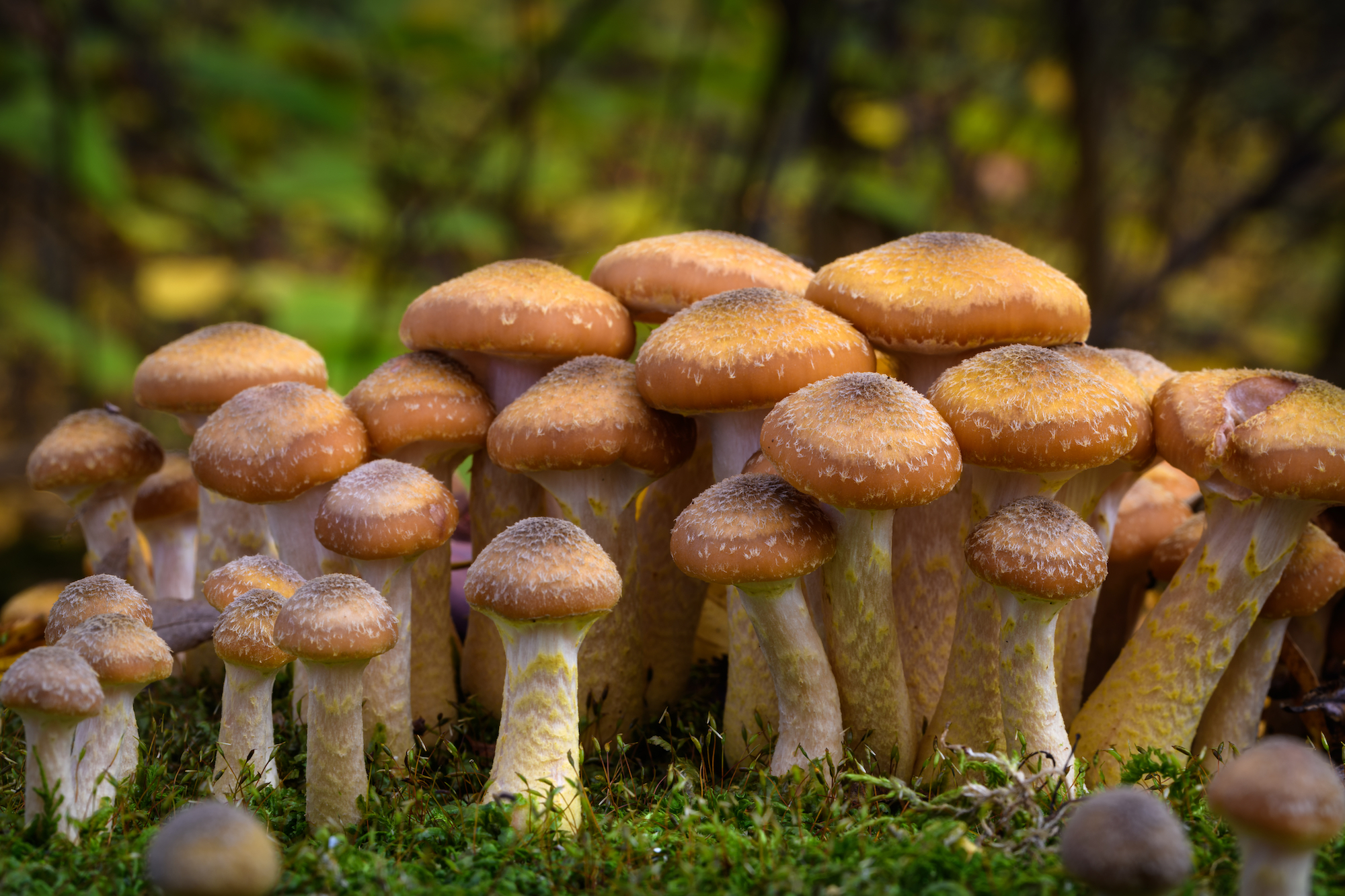
Agaricus Mushrooms (Agaricus spp.)
If you enjoy mushrooms at all, you’ve eaten an Agaricus before. This group includes the “button” mushrooms available in most grocery stores. It also includes prized wild mushrooms like the prince mushroom (Agaricus augustus), which usually grows in deciduous and coniferous forests.
That said, there are many toxic mushrooms in the Agaricus family as well as several lookalikes in the Amanita family. Learning to correctly identify these mushrooms before using them is essential.
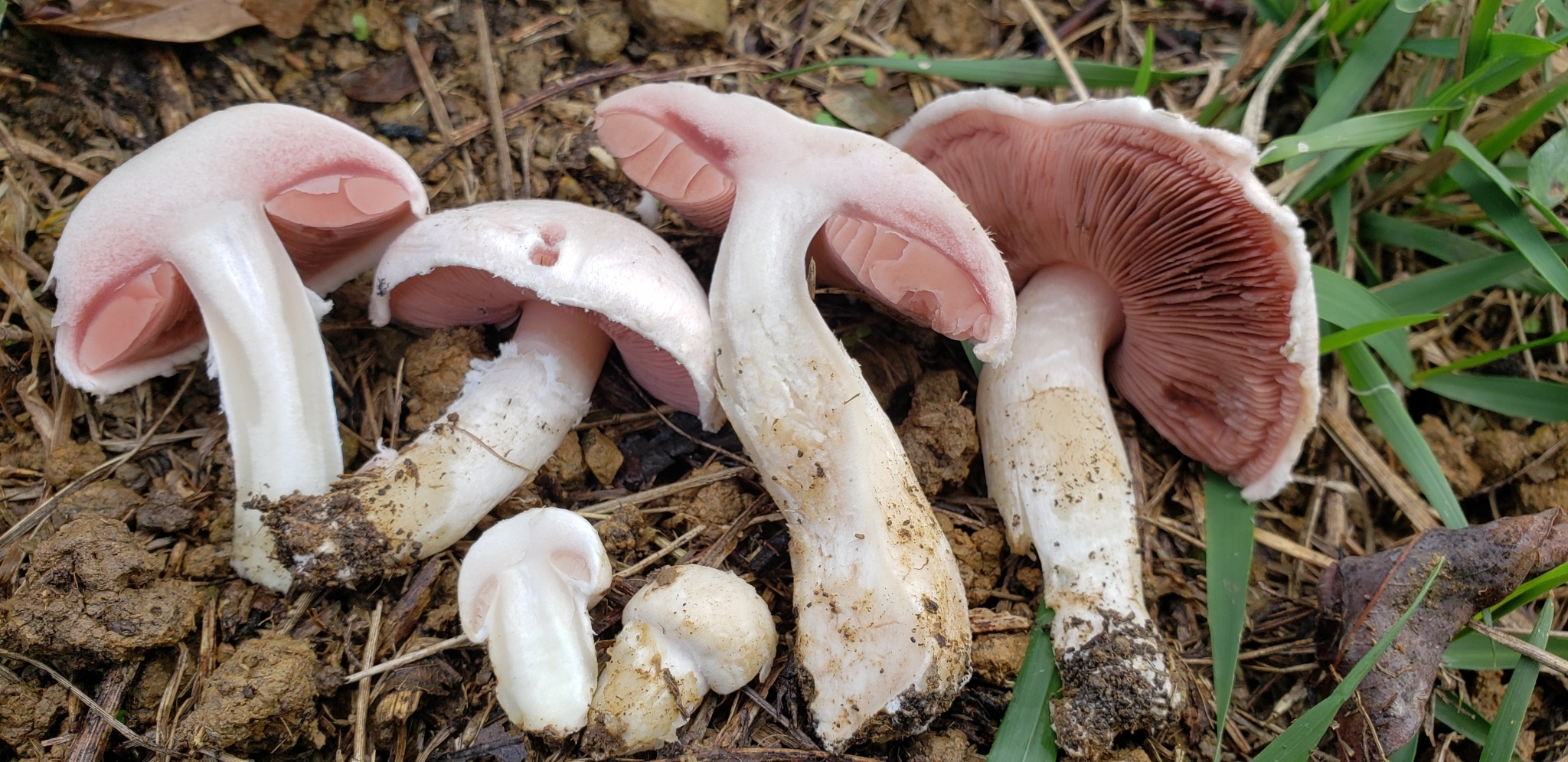
Caesar’s Mushrooms (Amanita caesarea)
Caesar’s mushrooms are named for the Roman emperors who loved to serve them, who traditionally took the name “Caesar’ as a title. It’s easy to understand why they fell for these beautiful mushrooms. They’re tender, fragrant, and slightly nutty with hints of chestnut or hazelnut flavor.
That said, Caesar’s mushrooms are difficult to positively identify. While they’re fun to look at, we recommend only advanced foragers collect and eat them.
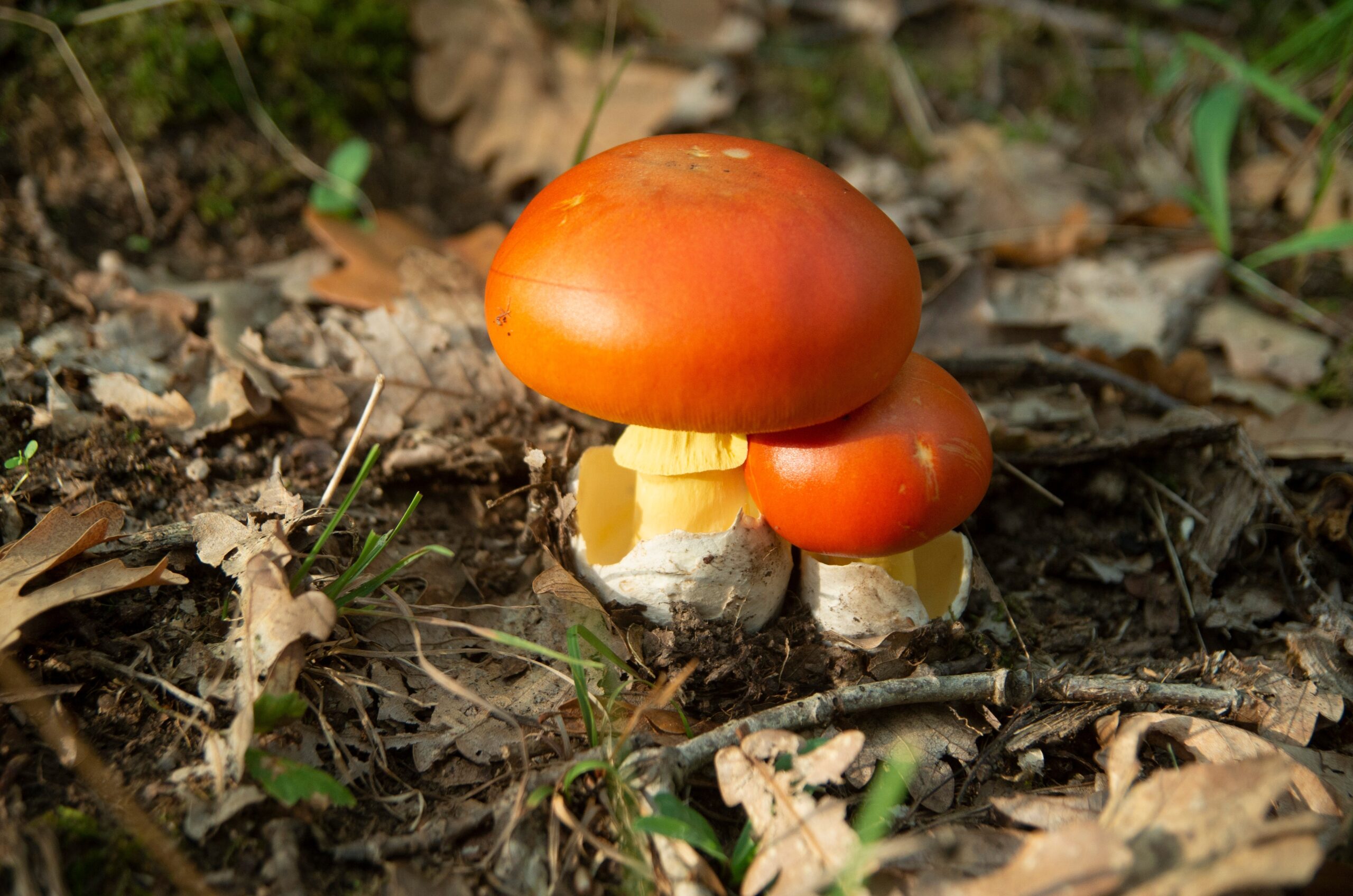
Coral Mushrooms (Clavariaceae spp.)
Coral mushrooms may not be the most sought-after wild mushrooms, but their beautiful, delicate appearance and excellent flavor make them a worthy option. There are many species of coral mushrooms, and not all are edible, so this one is generally not recommended for beginners.
The name coral mushrooms covers a wide range of coral-shaped fungi. They all have different habitats, flavors, colors, and other attributes. Learning to identify a few of the coral mushrooms in North America can expand your foraging horizons.
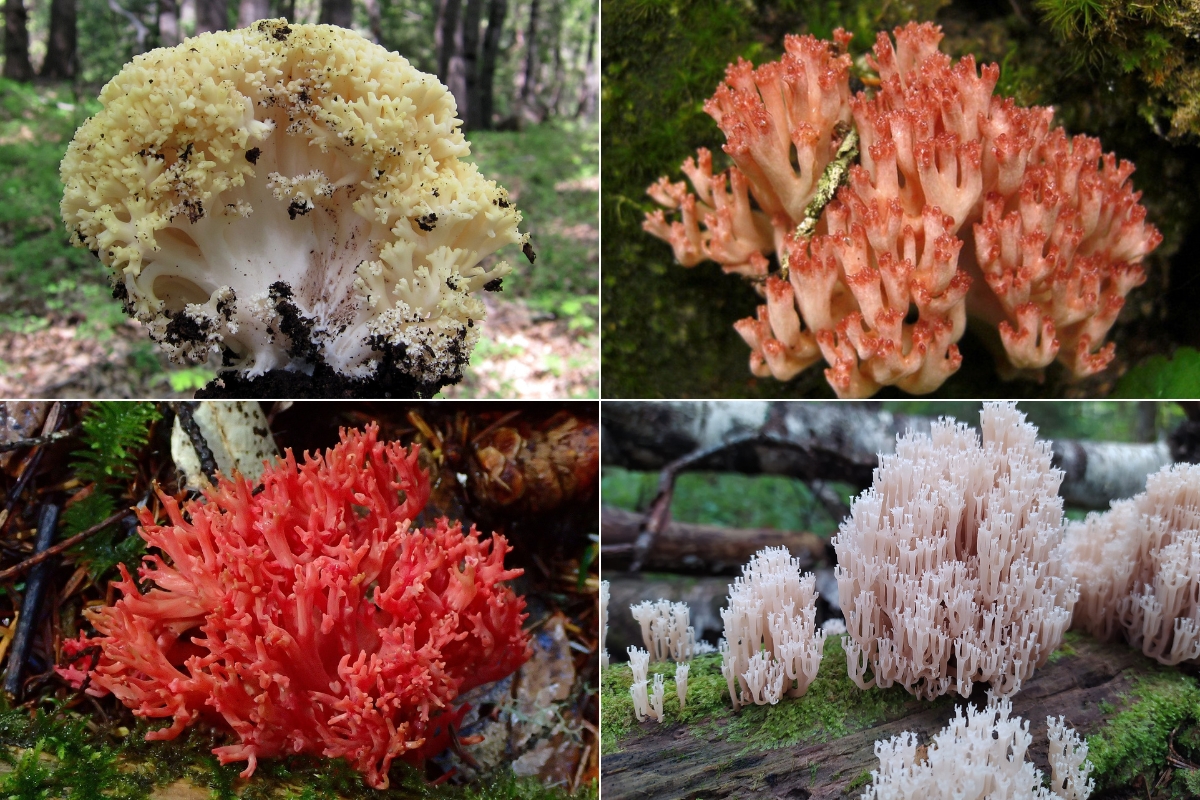
Matsutake (Tricholoma matsutake)
Matsutake mushrooms have a lot to offer. Their medicinal properties and excellent flavor have made them a prized mushroom for foragers, chefs, and herbalists. In Japan, they’re sometimes known as the “king of mushrooms” and may cost hundreds of dollars a pound!
Thankfully, you can find these mushrooms in the forests of North America. Matsutake have a mycorrhizal relationship with trees, so you’ll always find them in the woods. They do particularly well in pine forests.
Matsutake are not beginner mushrooms. They have toxic lookalikes and require proper preparation to taste good, but if you’re up for a challenge, learn to identify them. They’re worth it.
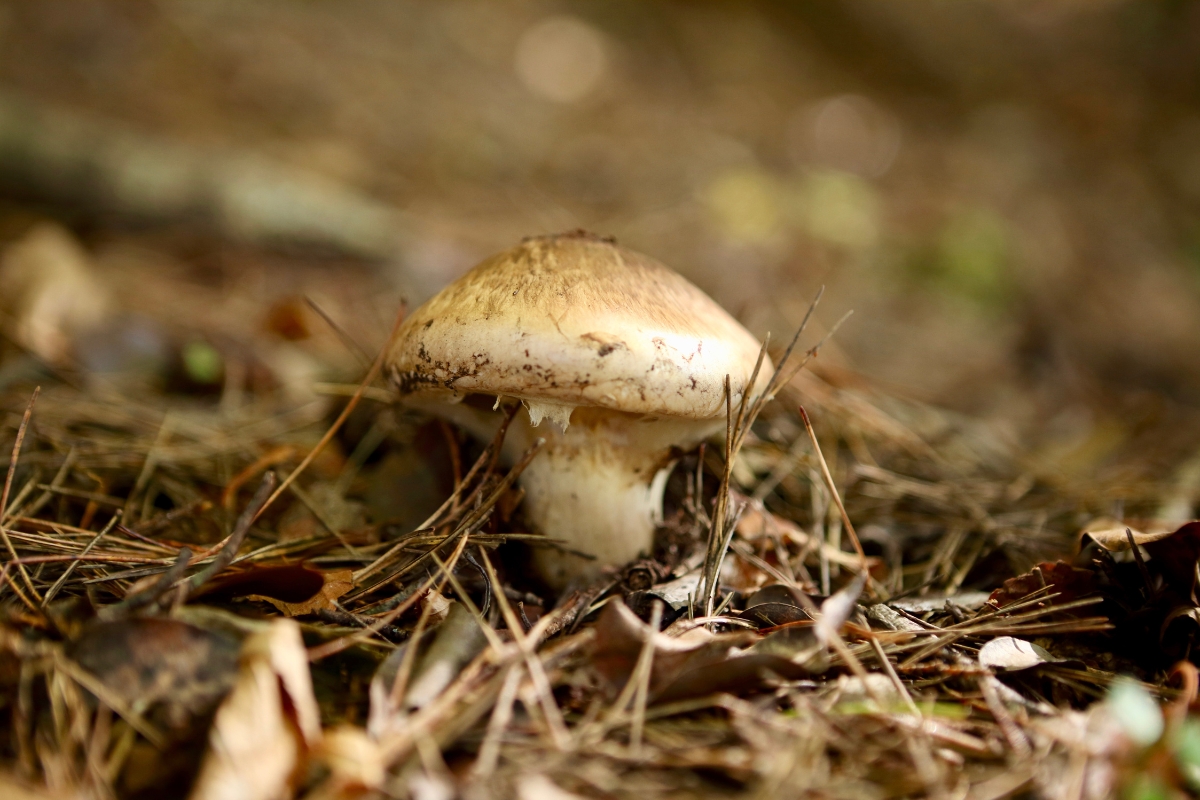
Deer Mushrooms (Pluteus spp.)
Deer mushrooms aren’t the most flavorful or sought-after wild mushrooms, but they’re worth getting to know. Despite being relatively mild, they make decent edible mushrooms when cooked with more flavorful ingredients.
Deer mushrooms are also accessible to many foragers. A few key points can allow you to identify them safely. They’re widespread, fruiting even in urban areas, and may fruit throughout the year during all four seasons.
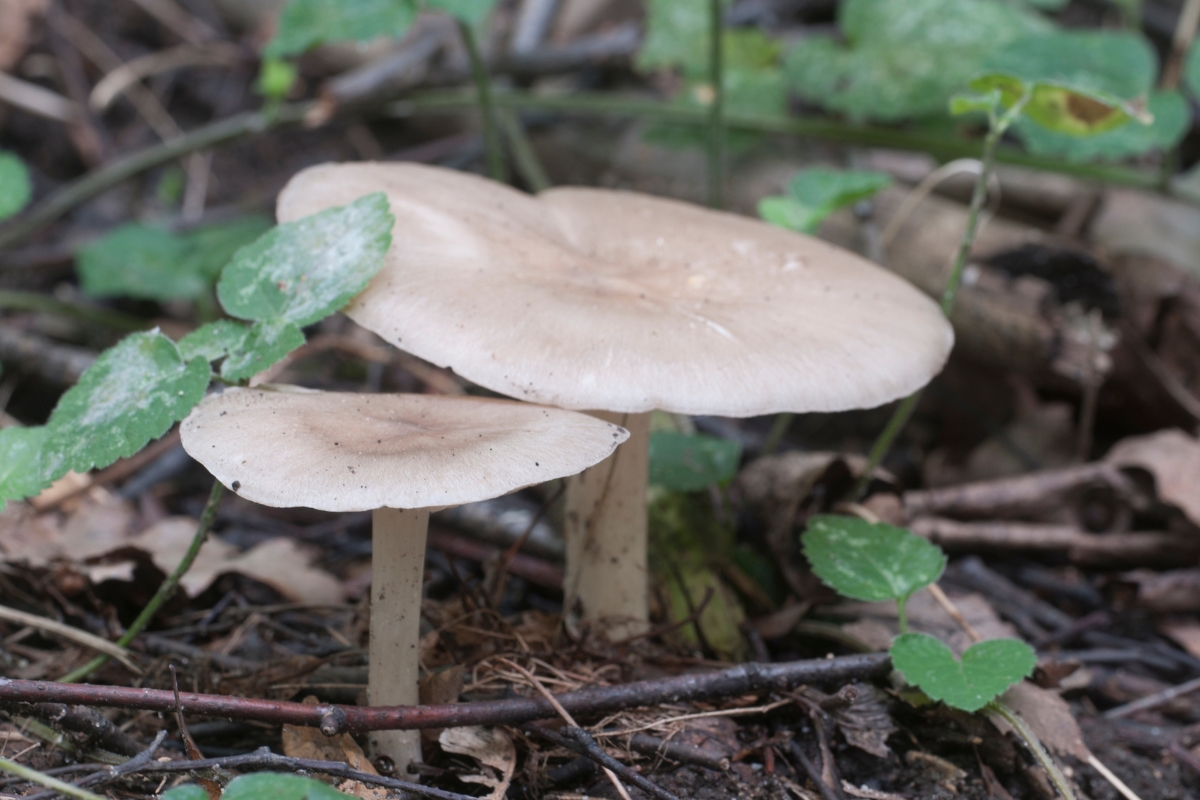
Parasol Mushrooms (Macrolepiota procera)
Parasol mushrooms grow in pastures, lawns, and occasionally open woodlands in temperate areas. They may grow alone or in small groups, sometimes forming circles known as fairy rings.
They have a delightful nutty, slightly sweet flavor that makes them enticing to foragers. However, they must be cooked properly, or they may cause an upset stomach.
Parasol mushrooms also have some toxic lookalikes, so be sure of your identification before eating them.
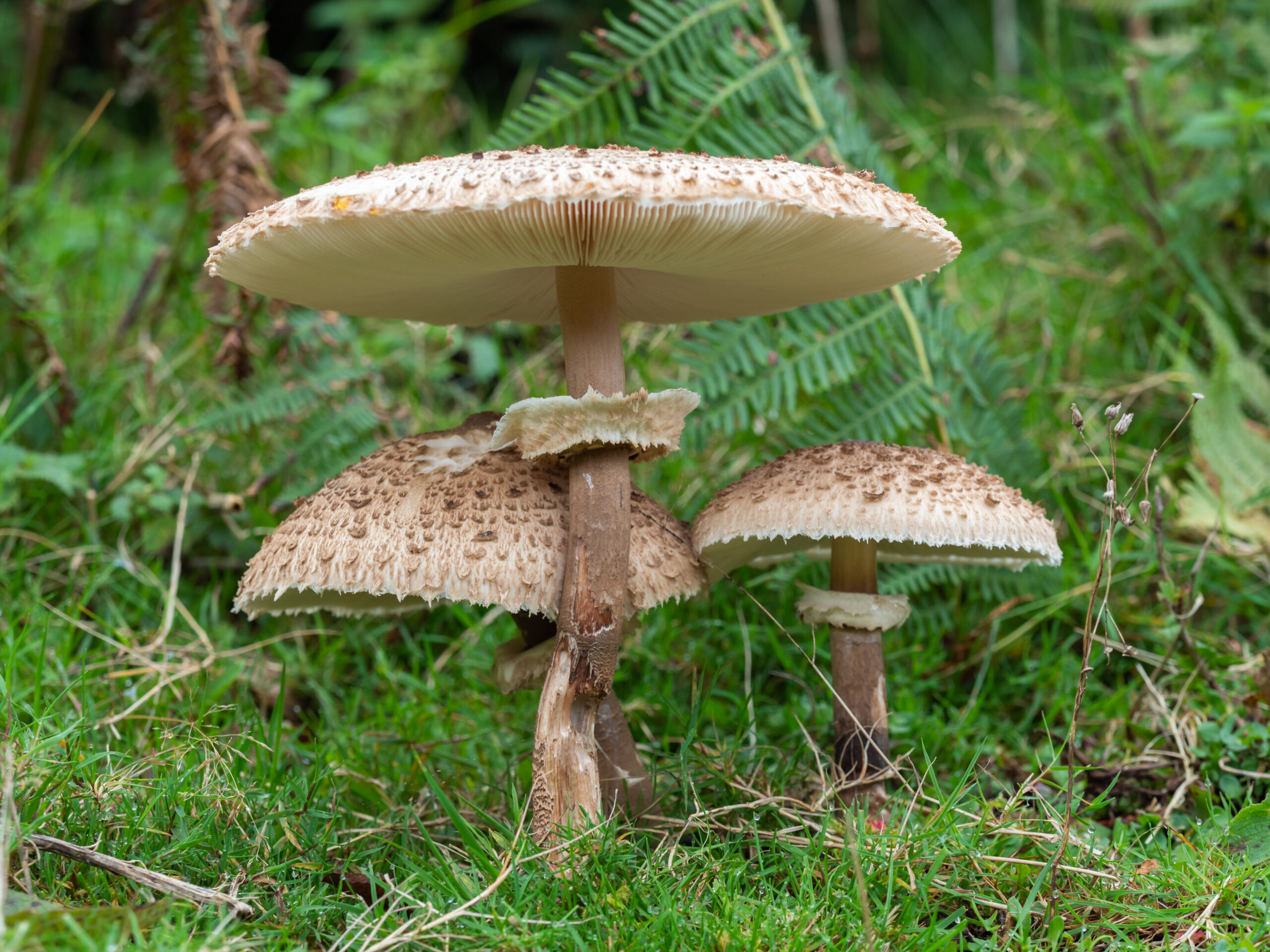
Russula Mushrooms (Russula sp.)
Russulas are among the many overlooked edible mushrooms. Many foragers find them mild and unworthy of gathering, but they do have some ardent fans.
Russulas can be challenging to identify, and there are both edible and toxic species. You’ll find them growing beneath hardwood forests in summer. Unfortunately, they often grow singly, so it can be hard to gather a good batch.
Quilted green russulas are brittle and hard to transport but are still worth picking. They have a mild, slightly nutty, or fruity flavor that’s even stronger once they’ve been dried. They’re good candidates for a number of recipes.
There are a number of Edible Russula species, and this guide walks you through several of them:
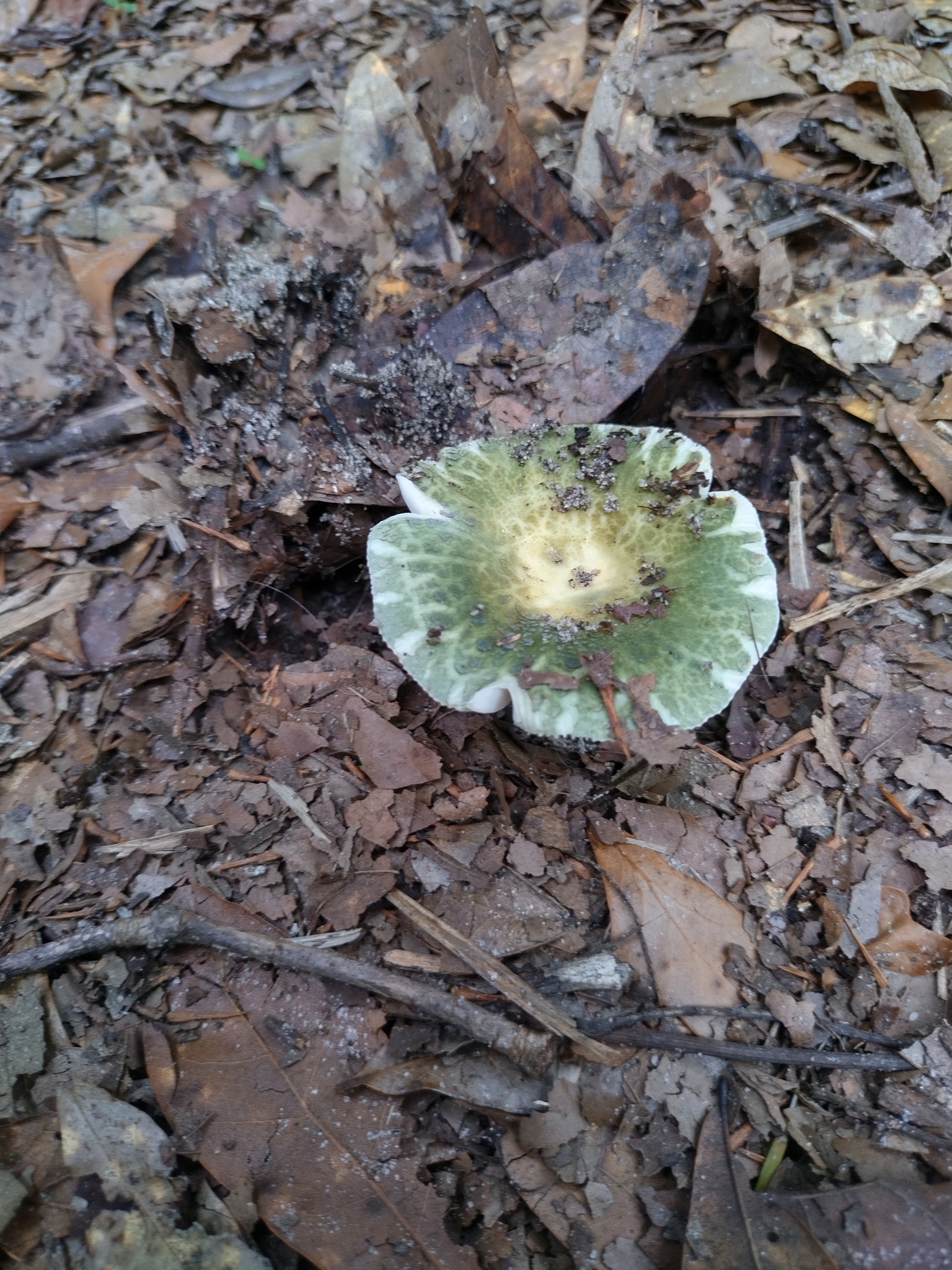
Amethyst Deceiver Mushrooms (Laccaria amethystina)
Amethyst deceivers may be some of the prettiest mushrooms in North America. When young, their caps are a striking vivid purple. However, they do tend to lose their color with age.
These stunning summer mushrooms are edible, but many foragers choose just to appreciate their beauty. Amethyst deceivers are small, and you only want to collect the caps; the stems are too tough to be enjoyable.
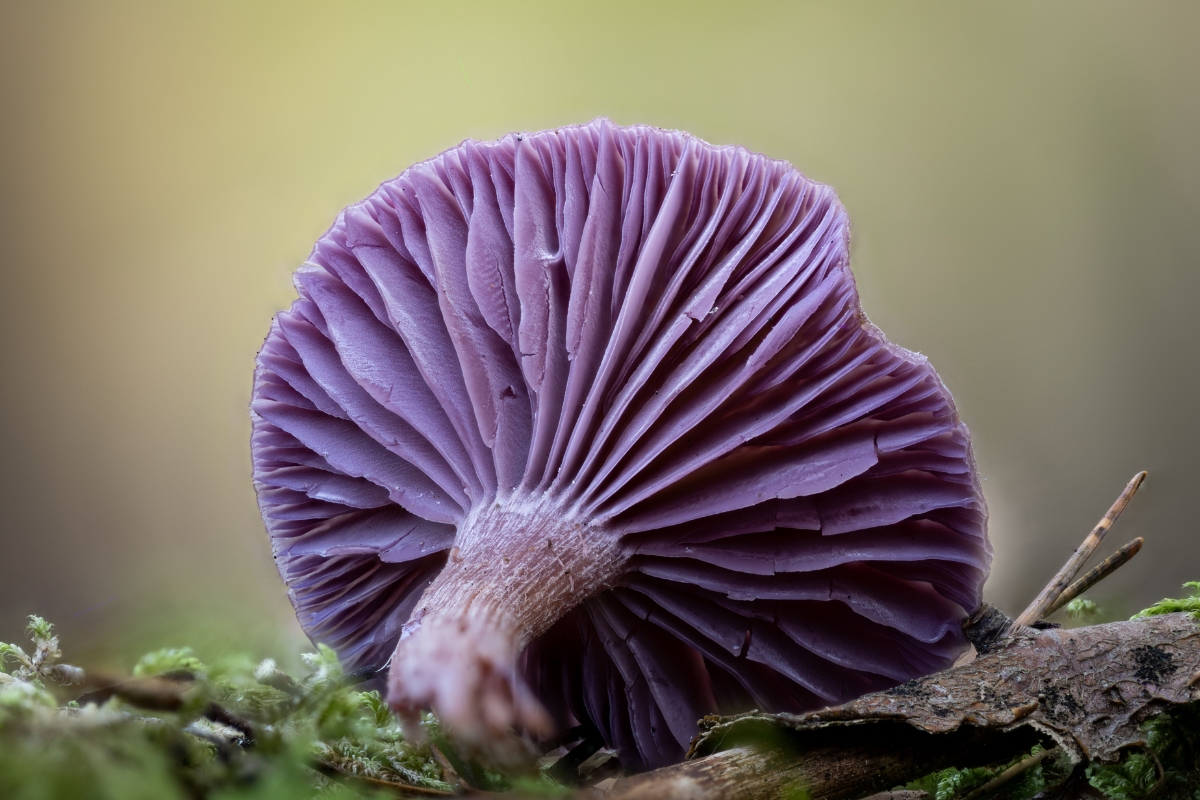
False Morels (Gyromitra spp.)
In the spring and early summer, a species starts popping up that most foragers avoid, the toxic false morel. Oddly, if you read a lot about foraging, you’ll probably run into reports of people eating these deadly mushrooms and living to tell the tale.
Most false morel or Gyomitra species contain a compound called Gyromitrin, which the human body metabolizes into Monomethylhydrazine, a major component in rocket fuel. Despite this, some people in Michigan’s Upper Peninsula, Germany, Scandinavia, and Eastern Europe still regularly consume these unusual mushrooms.
To rid the mushrooms of their toxic compounds, they carefully blanch them in boiling water, but even cooking them can be unsafe. These mushrooms must be prepared outside or under a vent hood because the fumes they release are toxic.
Personally, I avoid these mushrooms and suggest that most novice foragers avoid them altogether. Don’t consume false morels without the guidance of an expert forager who knows how to harvest and cook them properly.
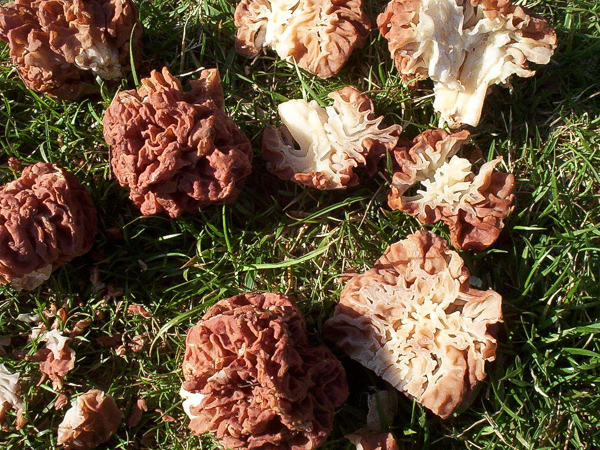
Mushroom Foraging Guides
Looking for more mushroom foraging guides?
- 20+ Mushrooms to Forage in Spring
- 16+ Mushrooms to Forage in Winter
- 13+ Edible Wild Mushrooms for Beginners


